Products
In all product sheets you will find detailed information about them, characteristics, dimensions, availability, etc. However, we can think of other questions and answers that may be of interest to you. Remember that for any questions you can contact us.
In our e-commerce, we offer a wide range of products, each with its own story and origin. We collaborate with talented artisans both locally and internationally, ensuring that each piece meets the highest standards of quality and authenticity.
Our catalog includes masterpieces from the best armory masters, among which the iconic swords of Toledo stand out, known for their excellence, as well as bladed weapons from renowned producers in Solingen, Germany. These products are not only functional but also unique pieces that represent the tradition and culture of their places of origin.
Furthermore, our products come from various factories in countries such as Spain, U.K., China, India, Pakistan, the United States, Germany, the Czech Republic, the Netherlands, Hungary, Italy, and France, among others. This variety allows us to offer a unique assortment that encompasses numerous techniques and manufacturing styles.
It is important to highlight that all products manufactured outside of Spain are rigorously controlled upon their entry into the country, ensuring compliance with established quality and safety standards. Thus, you can acquire our items with total peace of mind, knowing you have made a safe and quality choice.
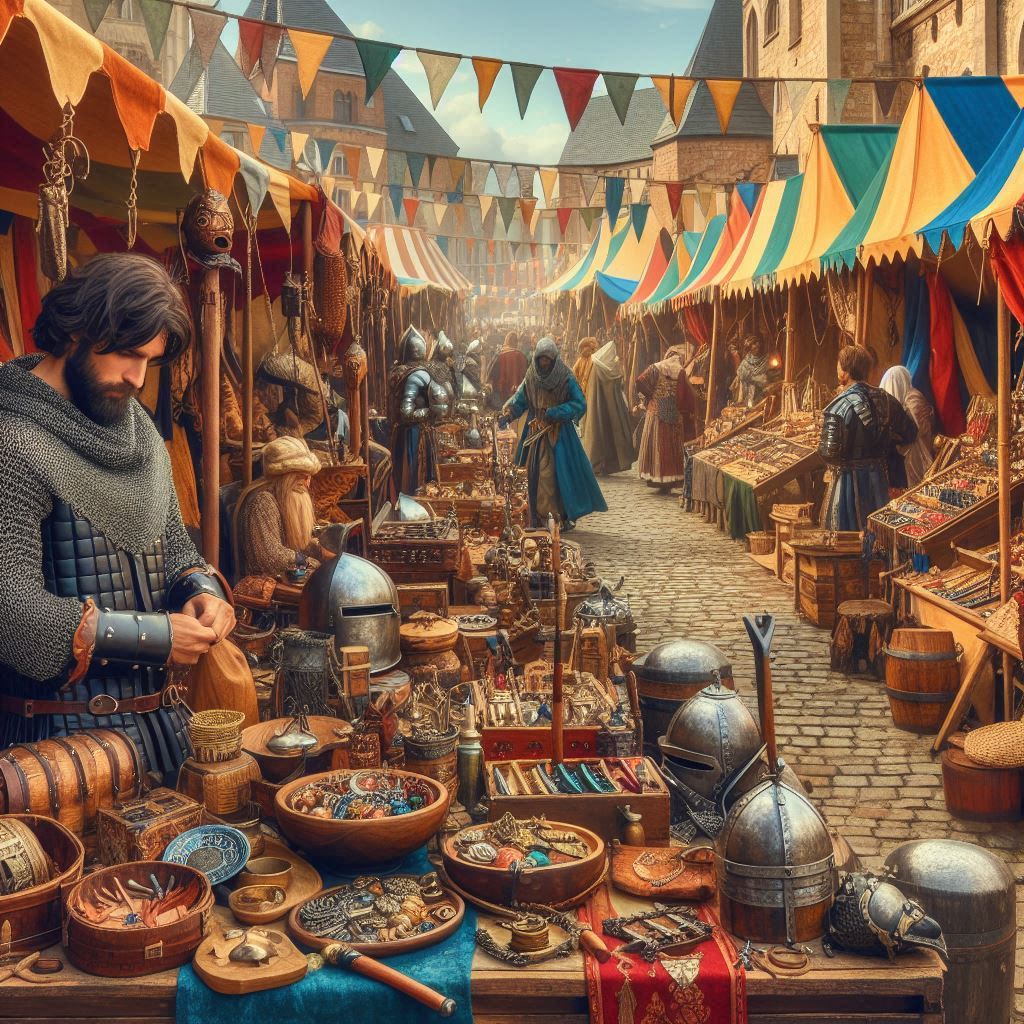
Of course! In our wide catalog, we offer a selection of products that can be customized according to your tastes and needs. In particular, for products like swords for communions or swords for weddings, you will have the opportunity to add a special text that will be engraved on the blade of the sword, adding a unique and memorable touch to your purchase. This type of customization is perfect for such special occasions.
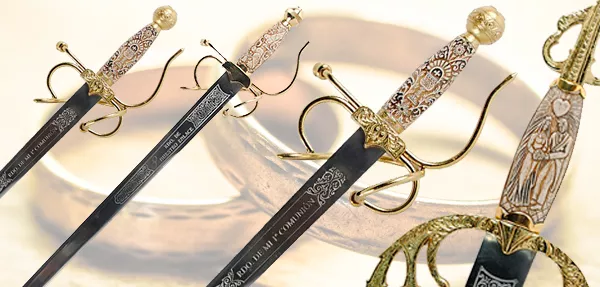
Additionally, we have a section dedicated to Heraldry, where you can customize a variety of products with the shields representing your names and surnames. These medieval items are highly sought after and become true unique pieces that reflect your identity.
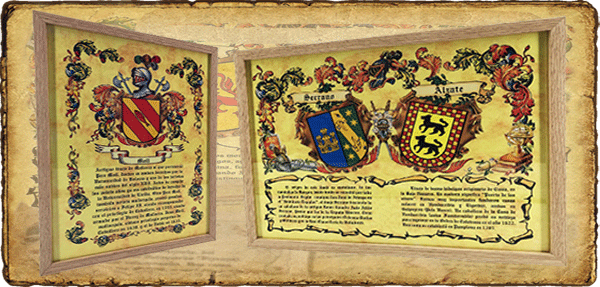
It is essential to mention that, in some bladed weapons, there is an option to sharpen them. However, this feature depends on the manufacturer, and not all products are suitable for it. Additionally, many of our bladed weapons can be engraved with custom designs, giving you the opportunity to add an even more personal touch.
If you have any questions or need more information about the customization process, feel free to check our FAQ section or review the product sheets. We are excited to help you create a product that perfectly fits your wishes and needs.
The warranty for products purchased in our store is a fundamental aspect to ensure the trust and satisfaction of our customers. In the event that a product exhibits manufacturing defects, we will proceed to resolve the situation in the most appropriate manner for the consumer. This may include repair, replacement of the product, a price reduction, or contract termination. All of these processes are completely free for the consumer.
The law states that we are responsible for non-conformities that manifest within a period of three years from the delivery of the product. This delivery will be understood as occurring on the date indicated on the invoice, the purchase receipt, or in the delivery note, if it is subsequent. Additionally, there is a favorable presumption for the consumer: it will be considered that the non-conformities that appear within the two years following delivery already existed at the time the good was delivered.
The consumer can exercise their right to rectify the non-conformity through a simple declaration. When opting for repair or replacement of the product, it is important to highlight that these alternatives will be implemented unless they are impossible or involve an unreasonable cost for us as sellers. Any measure we take to adjust the product to conformity must meet the following criteria:
- Be free of charge for the consumer, covering all necessary expenses, including shipping and transportation costs.
- Be carried out within a reasonable period from the time we are notified of the non-conformity, avoiding further inconvenience to the consumer.
The consumer must make the good available to us, and we will take care of recovering it at our expense in a manner that involves the least inconvenience to the client, taking into account the type of good. We will not be responsible for additional payments for the normal use of a good that has been replaced before the delivery of the new product.
In the case of products that have been installed, we will take care of removing the non-conforming good and proceed to install the repaired or replaced item, assuming all costs associated with this action.
In addition, we will provide the consumer with the appropriate documentary justification regarding the delivery of the good, including the delivery date and a description of the non-conformity. We will also provide the consumer with the corresponding proof of the delivery of the conforming good.

The consumer also has the right to demand a price reduction or contract termination. The price reduction will be proportional to the difference between the value the good would have if it were conforming and the actual value of the good at the time of delivery. However, contract termination will not proceed if the non-conformity is not significant.
These alternatives may be requested when:
- The business has not carried out the repair or replacement adequately.
- The non-conformity in the repaired or replaced good is considered serious.
- The solution to bring the good into conformity is impossible or excessively burdensome.
- It is evident that there is not a reasonable period to resolve the situation.
If these alternatives are chosen, the business will reimburse the consumer the price paid for the goods after receiving them or upon presentation of a receipt proving their return. Furthermore, the consumer has the right to suspend any pending payment until they fulfill their obligations.
Finally, if the consumer finds themselves in a situation that limits the use of the good due to the violation of third-party rights, they may request the rectification of the non-conformity, the reduction of the price, or the termination of the contract. In any case, they will not be responsible for any additional payment for the normal use of goods that have been replaced during the claim process. If the established assumptions apply, they may also demand compensation for damages that may have occurred.
To find out if a product is in stock in our online store, we have implemented a clear and transparent system that provides you with updated information on each product page. Here’s how it works:
Within each product page, you will find labels indicating its availability status. These statuses may include:
- In stock: If the product is available for immediate shipping, a label will confirm this. This means we have it in our warehouses and it can be dispatched as soon as possible.
- Estimated production time: If an item is not available immediately, an estimated time for its production will be displayed. This time is approximate and may vary; sometimes, the timelines can shorten, while at other times they may be extended.
To facilitate this check, we have designed the following visual section:

As you can see in the image above, products available for immediate shipping will be clearly marked, allowing you to easily identify them.
On the other hand, if a product is in production or needs to arrive at our warehouses, you will see a label like this:

We want to remind you that, although these labels are accurate, we always recommend contacting our team via email to obtain the most updated information about the availability of any product. This is especially useful for high-demand items or if you need urgent confirmation.
Additionally, our customer service team is always ready to clarify any questions related to delivery times and availability, thus ensuring a satisfactory and surprise-free shopping experience. Your satisfaction is our priority.
The bardiche, also known as the berdiche, is a historically significant weapon that combines the characteristics of an ax and a pole weapon. Primarily used from the 14th to the 17th centuries in regions such as Eastern Europe, especially in Russia, it is a perfect example of the evolution of weaponry during the Middle Ages and the Renaissance.
Characteristics of the Bardiche
- **Structure**: The bardiche features a blade reminiscent of a war ax or a glaive. The uniqueness of this weapon lies in the blade being attached to a pole at at least two points, allowing it to be gripped behind the blade, acting as a kind of guard. This design provides additional stability and control for the user. - **Length**: The bardiche blade typically measures between 60 to 75 centimeters. As for the pole, it can measure from one meter to one meter eighty in length, granting the weapon considerable reach in combat. - **Usage**: Noted for its versatility, the bardiche was used for both slashing blows and thrusting, demonstrating its effectiveness in close-quarter combat.
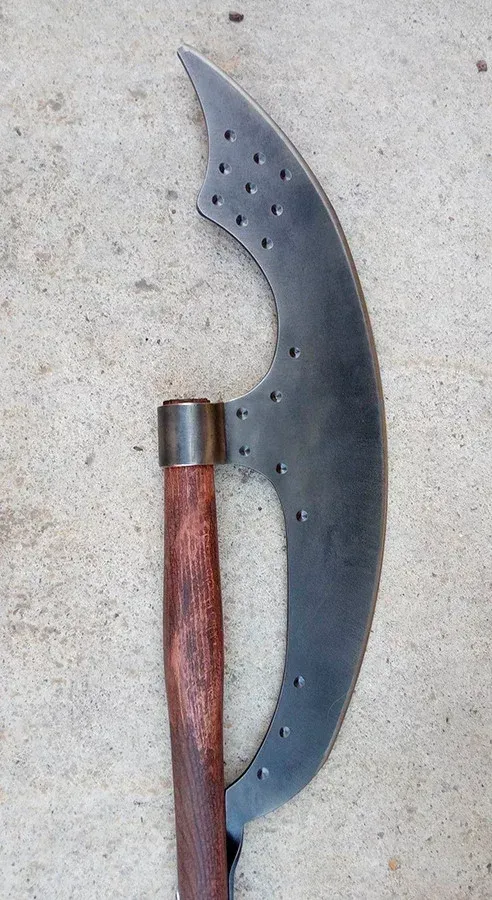
Origins and History
- **Origin of the term**: The word "bardiche" is an adaptation of the Russian "berdiche," which literally means "pole ax" or "long ax." - **Presence in Eastern Europe**: This type of weapon was distinctively popular in Eastern Europe, with extensive use in Russia among infantry ranks. Its design was ideal for the type of battles and fighting styles predominant in the region. - **Spread**: Starting in the 15th century, the bardiche began to spread to other territories such as Austria, Sweden, and the Polish-Lithuanian region, gaining ground in the arsenals of heavy infantry. - **Use in Russia**: During the reign of Ivan the Terrible, the bardiche was solidified as the main service weapon of the palace guard, known as the streltsy.Use in Combat
- **Versatility on the battlefield**: The bardiche was not just a cutting weapon. Its structure also allowed it to be used as a support tool for firing muskets, serving as a leveling device to improve shooting accuracy. - **Functionality**: In combat, it provided both a powerful strike and the capability of being used as a spear, allowing the warrior to keep their opponents at a certain distance.
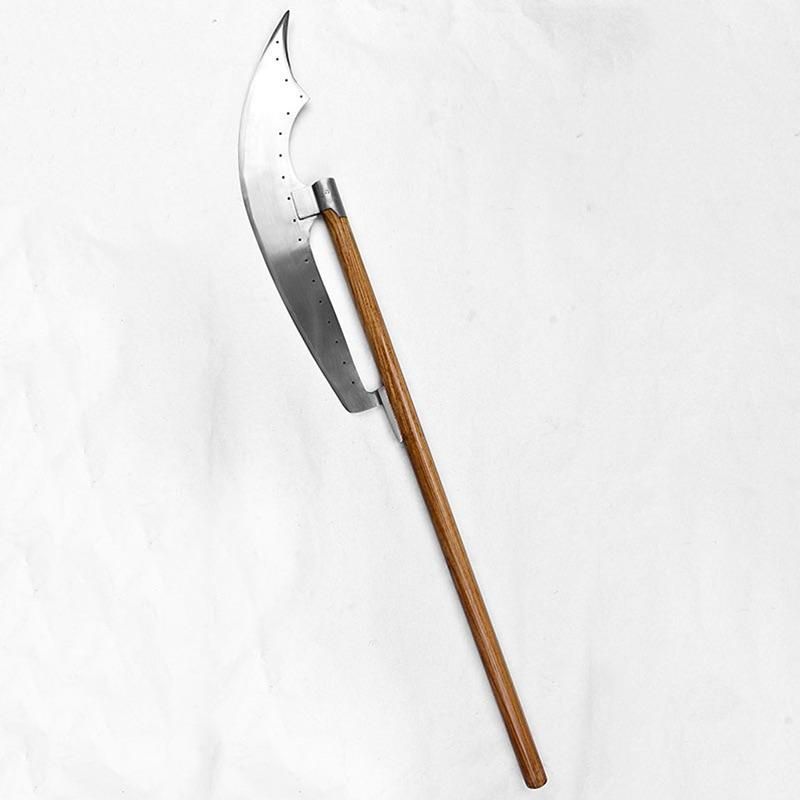
Comparison with Other Weapons
- **Differences from the Halberd**: Unlike the halberd, the bardiche does not have the characteristic spear point or hook on the back of the blade. These differences make it simpler in design, but no less effective. - **Similarities with the Glaive**: Like the glaive, the bardiche features an ax-like blade, but its distinctive mounting and method of use mark it as a unique weapon. The bardiche represents a fascinating intersection between ax design and pole weapons, reflecting not only the history of warfare in Eastern Europe but also military innovation over the centuries. Its adaptability to different combat tactics solidifies the bardiche as a crucial item in the arsenals of infantry units during its era of popularity.The history of humanity has always been imbued with the development of tools and weapons that served not only for survival but also as symbols of power and technological progress. Among these weapons, the Khopesh stands out as an emblematic creation of Ancient Egypt, known both for its distinctive design and its effectiveness in close combat.
Origin and History of the Khopesh
The Khopesh, also called kefresh or jepesh, is a sword whose unmistakable shape has left an indelible mark on the archaeology of Ancient Egypt. Originally, its design was inspired by Mesopotamian battle axes, and although it was not an invention of the Egyptians, it was in this civilization where it reached its greatest development and popularity.
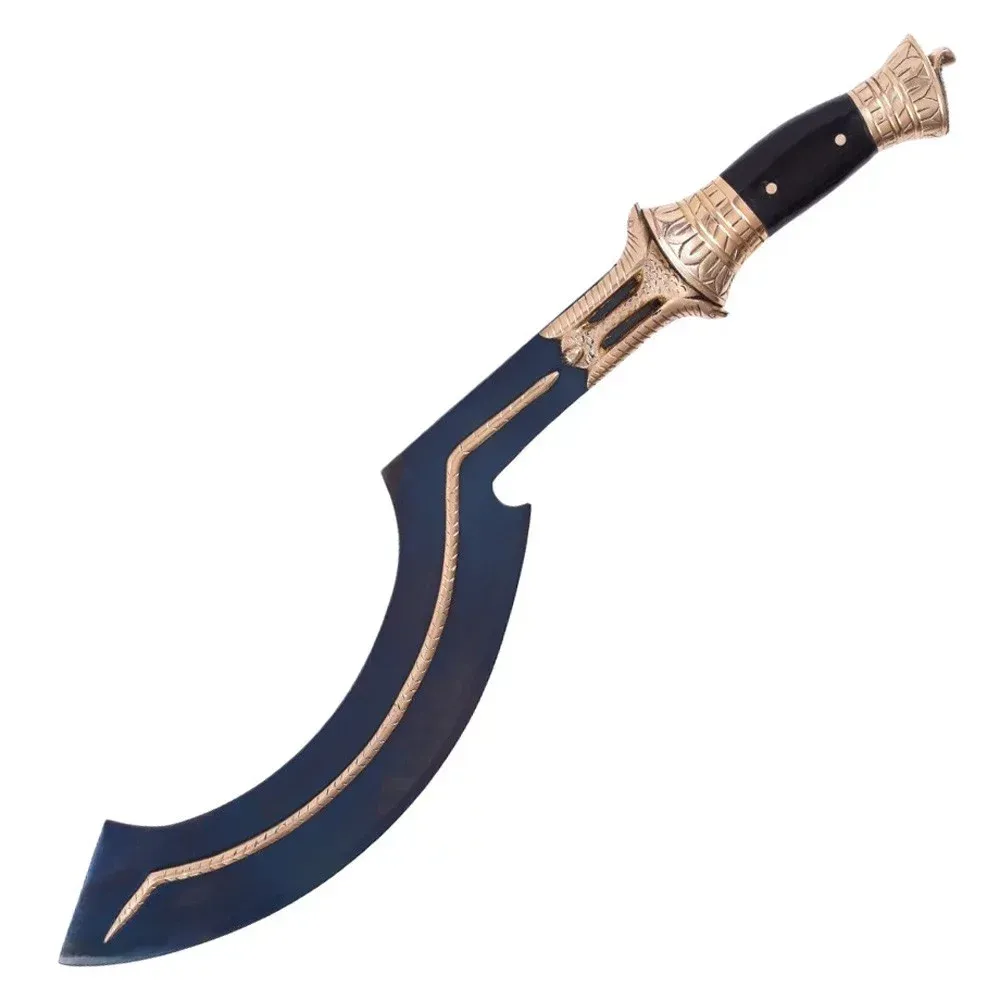
Characteristics and Design of the Khopesh
The design of the Khopesh is characterized by its C-shaped curved blade, resembling a sickle. This unique design places its edge on the convex part of the blade, allowing the sword not only to cut deeply in combat but also to become an excellent resource for attack and defense strategies. For example:
- It allows grabbing an opponent's arm.
- It can pull enemy shields, leaving them vulnerable.
Dimensions and Weight
In terms of dimensions, a typical Khopesh measures approximately 60 centimeters in length and has an average weight of 2.3 kilograms. This combination of size and weight makes it a formidable weapon that required skill and strength to handle effectively in combat.
Symbolism and Ceremonial Use
Beyond being a tool of war, the Khopesh held significant symbolic value. Frequently represented in Egyptian art, it was common to see images of pharaohs wielding this type of sword. In many cases, Khopesh swords were even buried with their royal owners, as is the famous case of Pharaoh Tutankhamun.
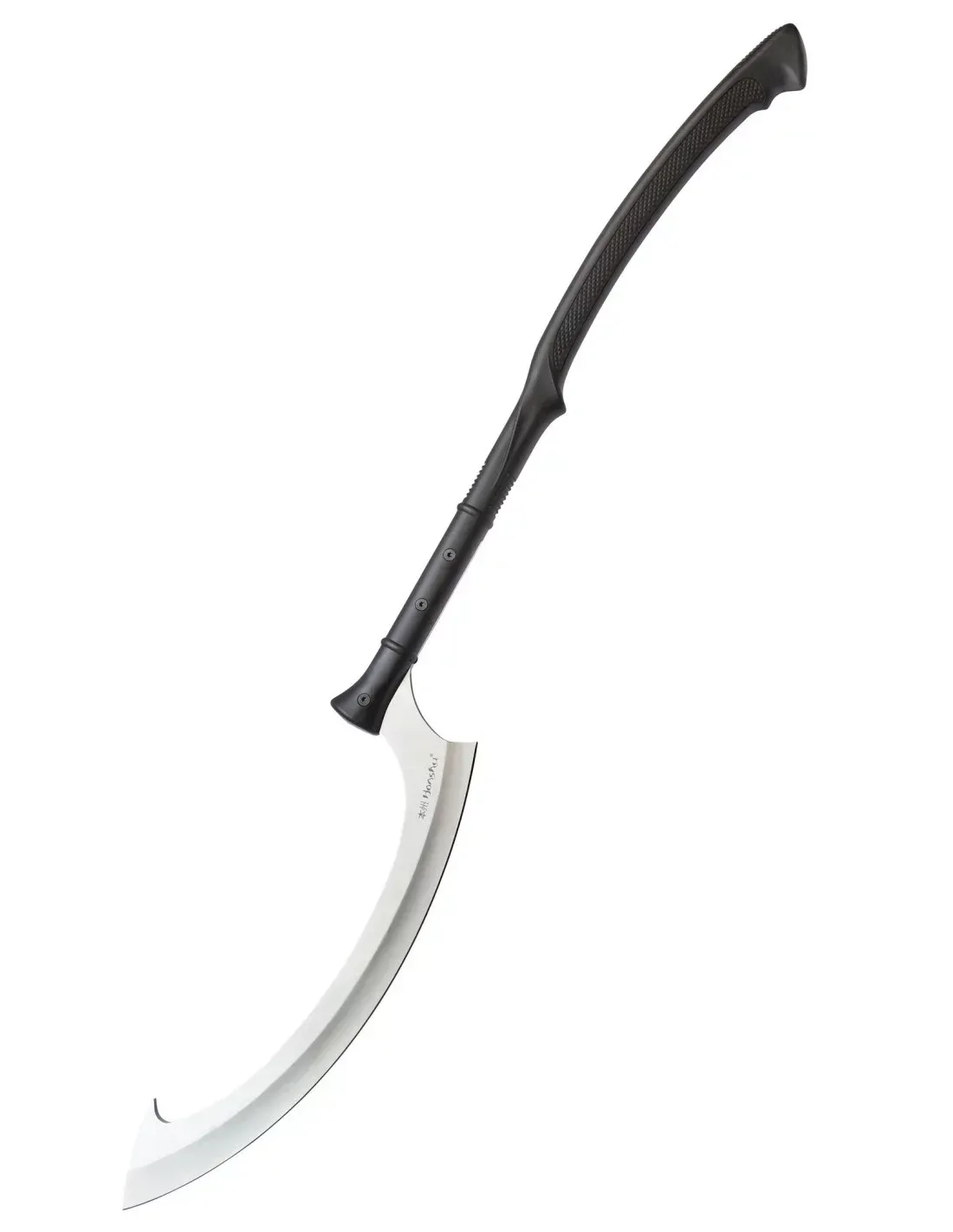
Evolution and Decline of the Khopesh
The popularity of the Khopesh began to decline around 1300 to 1200 BC. This change was largely a response to the evolution of other combat techniques and improvements in armor, which demanded a different approach to weaponry. Over time, the Khopesh was replaced by more conventional straight swords, which offered versatility in a wide range of warfare scenarios.
Legacy of the Khopesh
Although it is no longer used in modern times, the legacy of the Khopesh continues to be remembered as a masterpiece of Egyptian military design. The combination of military practicality and cultural symbolism cements it as one of the most fascinating remnants of ancient weaponry technology.
| Aspect | Description |
|---|---|
| Origin | Ancient Egypt, inspired by Mesopotamian axes. |
| Shape | Curved, C-shaped or sickle. |
| Size | Approximately 60 cm in length. |
| Weight | Average of 2.3 kg. |
| Purpose | Military and ceremonial. |
| Evolution | Replaced by straight swords around 1300-1200 BC. |
With its origins deeply rooted in the culture of the ancient Near East and its rise in Egyptian history, the Khopesh not only provides insight into ancient combat tactics but also the symbolic significance that these weapons held in their time. The fascinating tradition of the Khopesh continues to amaze historians and enthusiasts to this day.
The harquebus, one of the most iconic weapons of European infantry from the 15th to the 17th centuries, represents a crucial turning point in the evolution of military technology. This smoothbore firearm, a predecessor to the more advanced musket, was key in transforming armed combat by providing infantry soldiers with a lethal weapon capable of easily penetrating armor.
Features of the Harquebus
This portable firearm is classified within the group of arquebuses and was known as "espingarda" in 16th-century Portuguese chronicles.
- Design and Structure: The harquebus featured an iron barrel, approximately one meter long, with calibers ranging between 15 and 20 mm. This barrel was mounted on a wooden stock, usually made of cherry or walnut, measuring about one and a half meters long.
- Firing Mechanism: It operated with a slow match ignition system. This meant that a lit match, located in a serpentine device, ignited the fine gunpowder in the pan upon pulling the trigger, firing the projectile.
- Weight and Length: Weighing between four and five kilograms, the harquebus measured between 1.2 and 1.5 meters, making it manageable yet robust.
- Range and Lethality: Its effective range was around 50 meters, sufficient to be lethal and penetrate armor at that distance.
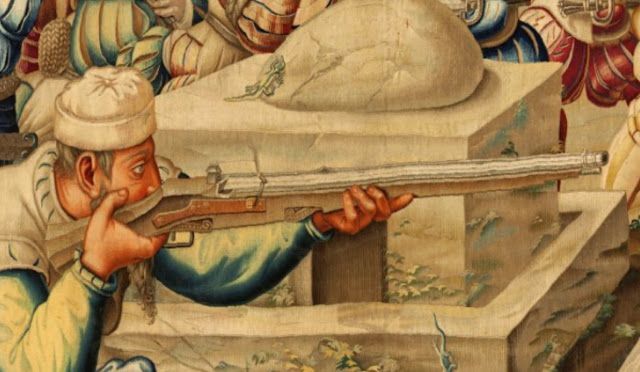
Usage and Evolution Over Time
The harquebus played a decisive role in various European conflicts due to its characteristics and the tactical change it promoted.
- Use in Warfare: Essential in infantry, the harquebus facilitated more dynamic and effective combat strategies against forces protected by armor.
- Historical Impact: A notable example occurred in 1522, when Spanish harquebusiers defeated Swiss pikemen at Bicoca. Another key event took place in 1525, with the defeat of heavily armed French knights at the Battle of Naples.
- Replacement by the Musket: With the advent of the musket, which featured a longer barrel and greater weight, the harquebus began to be replaced. The effectiveness and range of the musket represented a significant improvement, although it required a rest for proper aiming.

Sensitivity and Limitations of the Harquebus
- Weather Sensitivity: The powder of the harquebus was prone to dampness, rendering it unusable in rainy or humid conditions.
- Handling: Although it required less skill than the bow or crossbow, its proper functioning depended on the user's proficiency with the matchlock mechanism, which took time to master.
The harquebus quickly displaced the use of the crossbow in warfare, marking a significant shift in military technology. Its ease of use compared to conventional melee and projectile weapons of the time allowed more soldiers to be effective in less time.
The importance of the harquebus lies not only in its lethal capacity but also in its crucial role during a period of technological transition in military armament, laying the groundwork for modern firearms. Although it was eventually supplanted by the musket, its legacy endures as evidence of military innovation during the Renaissance.
```Heraldry is a fascinating discipline that focuses on the study and design of coats of arms and the codification of the rules for their correct representation and description. In the Middle Ages, these visual symbols served to identify participants in battles and tournaments. Over time, heraldry expanded beyond the military realm, reaching the nobility, the clergy, guilds, and even entire cities. Throughout the centuries, this rich visual tradition has evolved and continues to be relevant in the modern world.
Origin of Heraldry
The origins of heraldry date back to the 12th century in Europe, a period when visual emblems were essential for distinguishing individuals in collective events, such as tournaments and battles. Over time, these insignia became status emblems, used not only by knights and nobles but also by institutions like cities and guilds.
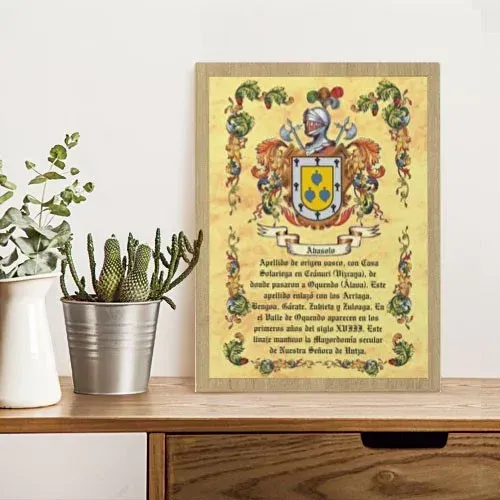
Elements of Heraldry
Coat of Arms
The coat of arms is the central component of any heraldic design. It features distinctive symbols that identify a person, family, or institution. These images can reflect marital alliances, achievements, and other historical frameworks, adding layers of meaning and lineage to the shields.
Armory
Armory encompasses all the components that form part of the coat of arms. It includes elements such as the helmet and crest, as well as various adornments, supporters, and mottos. These decorative details embellish the shield and reflect the history and values of its bearers.
Historical Symbolism of the Shield
Historically, the shield was not only a defensive tool in battle but also a symbol filled with meaning. It represents the strength and wealth of its bearers. Numerous myths, such as the story of Achilles' shield, emphasize the symbolism of the shield as a refuge that contains all the beauties of life and the universe.
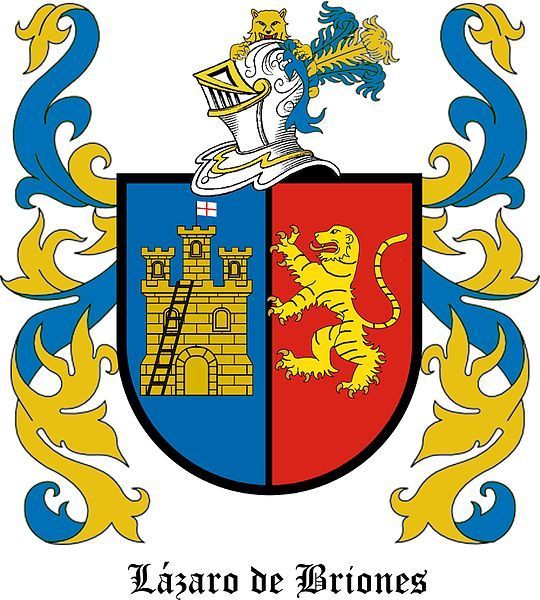
Rules and Traditions of Heraldry
Blazonry
The art of describing a coat of arms is known as blazonry, a specific language that includes its own terminology and syntax. In the description, one starts with the background color and then proceeds to detail the positions and colors of all the figures on the shield meticulously.
Organization of the Shield
The shield is systematically divided into nine zones known as points, each with its specific name. This provides a unified way to describe and read the complex arrangements of symbols on a shield.
Modern Use of Heraldry
Today, heraldry remains a significant method for the visual identification of families and surnames. Many people maintain their heraldic heritage in the form of framed artworks that include information about family lineage and history. These shields become tangible representations of personal and family identity.
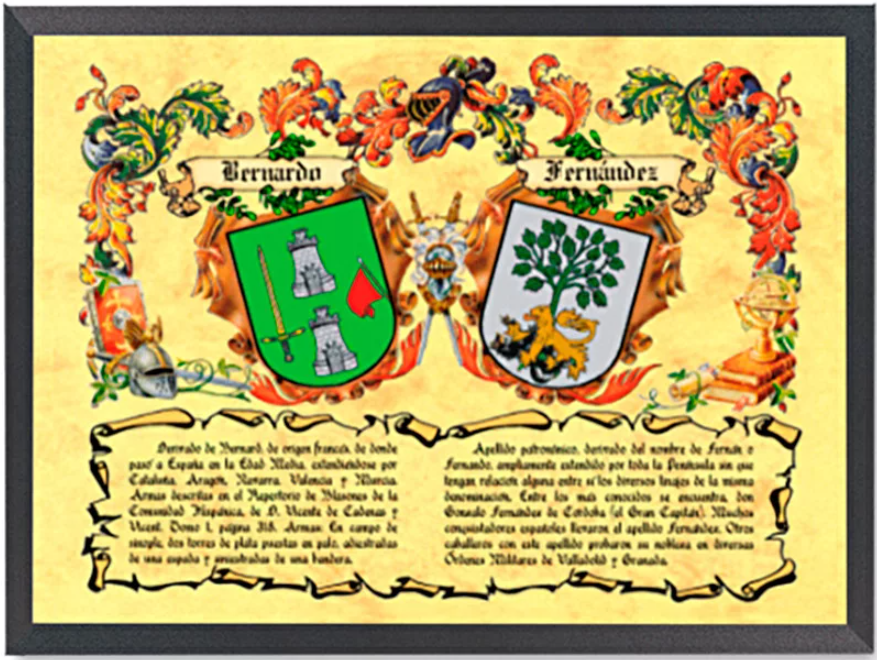
Heraldry continues to be a vital link to our past, offering a window into cultural and historical identity. The coats of arms and their complex compositions not only provide a visual means of identification but also preserve family stories through time. The rules of heraldry ensure that each symbol and color on the shield tells a story, keeping this millenary tradition alive.
The **mangual**, also known as a chain mace or flail, is a medieval weapon that captured the imagination of many due to its imposing design and utility on the battlefield. This instrument, whose origins lie in the evolution of a simple agricultural tool, became a powerful weapon of war that left its mark on history.
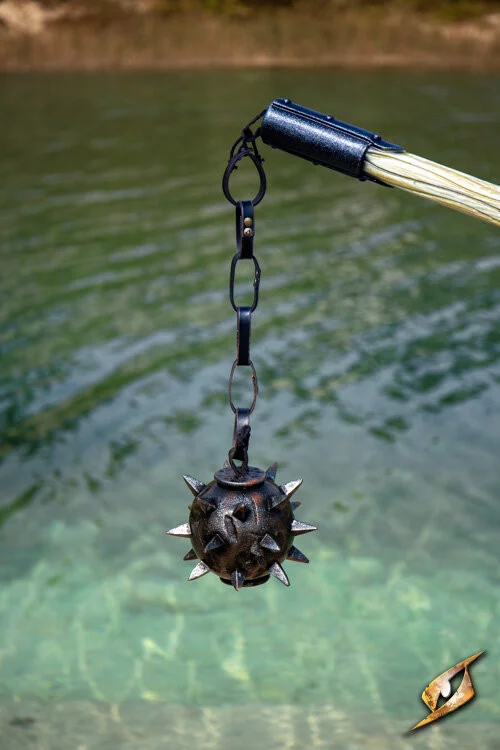
Origin and Innovation of the Mangual
The mangual has its roots in the "mayal," an agricultural tool used to separate grain from the husk. The transformation of the mayal into a weapon occurred by attaching a heavy iron mace to a wooden handle via a chain. This configuration granted the mangual a unique flexibility to bypass opponents' shields and strike with devastating force.
- Flexibility and Strength: The chain allowed the mace to swing over enemy shields, providing a clear tactical advantage.
- Handling and Danger: Using a mangual required training, not only for effective maneuvering but also to avoid personal injury due to its dangerous nature.
The Mangual in Medieval Battlefields
Used by both foot soldiers and knights, the mangual was the preferred choice against plate armor and defensive shields, thanks to the extra length provided by the chain. This weapon was particularly effective in close combat, where the strength and flexibility of the mangual could be maximized.
- Chains and Mace: It was common for the handle to have multiple chains, each ending in a spiked mace, thereby increasing its impact capability.
- Comparison with Other Weapons: Although similar in appearance to spiked maces, known in Europe as "morning stars," the mangual was distinguished by its chain, setting it apart from the more rigid flail.
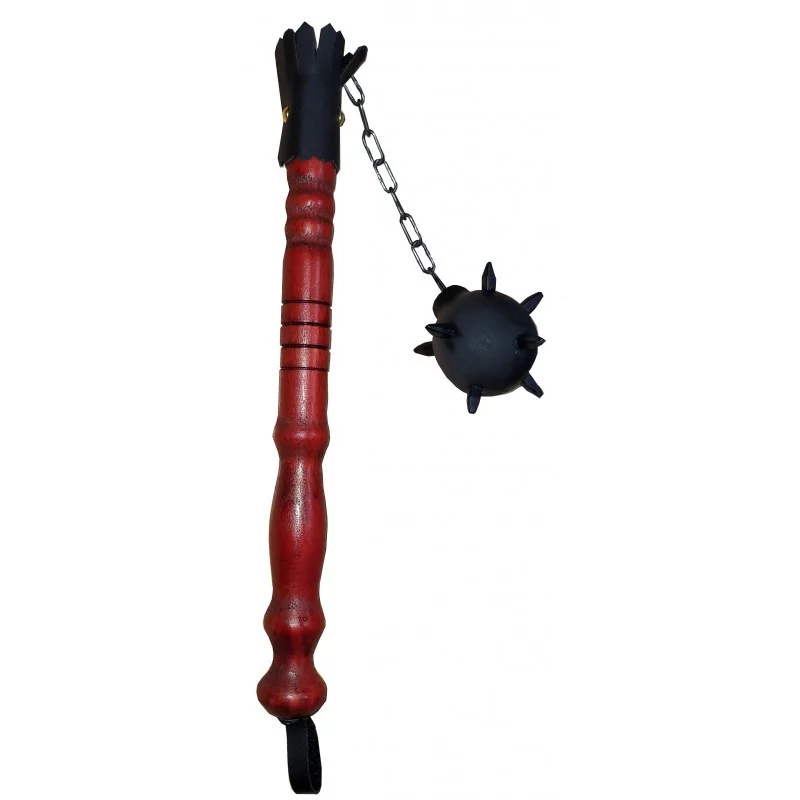
Geographic Presence and Historical Impact
The use of the mangual was prominent in regions such as Germany and Switzerland, although it does not seem to have had the same popularity in France. Its presence in armies reflected the need for effective weapons in close combat, where the ability to maneuver and block with agility was essential.
Modern Manufacturing of the Mangual
Today, it is possible to find resources that guide how to make a mangual at home, using materials such as motorcycle sprockets, chains, and pipes. Although these are usually used for recreational or educational purposes, they reflect the ongoing interest in this fascinating war instrument.
| Feature | Description |
|---|---|
| Origin | Derived from the agricultural mayal |
| Components | Wooden handle, chain, iron mace with spikes |
| Uses | Close combat, attacks against armor and shields |
| Regions of Use | Germany, Switzerland |
| Modernity | Homemade manufacturing available |
In essence, the mangual is a fusion of design and function, combining the deadly power of a mace with the adaptability of a chain. This weapon, which once dominated medieval battlefields, remains a subject of study and admiration for its uniqueness and effectiveness.
The Danish Axe, also known as Viking Axe, is one of the most emblematic weapons of the Middle Ages. This war tool originated in the Nordic peoples and quickly gained renown for its effectiveness and power in battles. In this article, we will explore its origin, structure, history, and legacy.
Origins and Description of the Danish Axe
Initially conceived as a lumberjack tool, the Danish Axe was adapted for military use due to its effectiveness and ease of handling. Originating from Northern Europe, its design and manufacturing reflect the technical skill of artisans of the time. The axe is primarily characterized by its large and wide blade, although thin, which provided an adequate balance between strength and lightness.
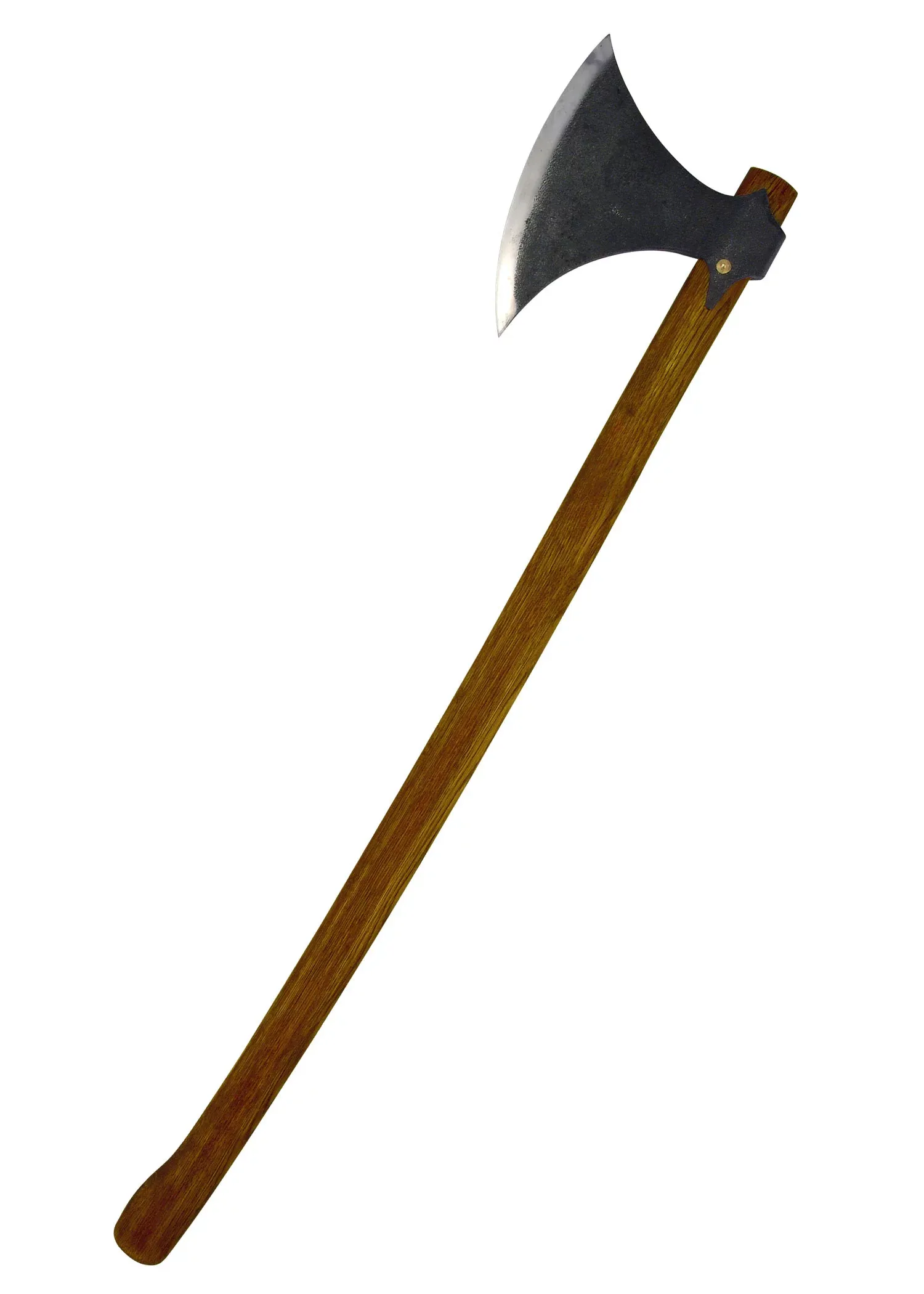
Morphology and Combat Use
The design of the Danish Axe is highly specific for war, making it stand out among other medieval weapons. The axe handle could reach between 120 cm and 180 cm in length, providing the wielder with a formidable reach. The blade, typically made of hard iron, measured approximately 30 cm in width, allowing for devastating cuts. These characteristics enabled the axe to be wielded efficiently with both hands, becoming a lethal tool in battles.
Its smaller and lighter head compared to other battle axes contributed to greater mobility, ensuring that Nordic warriors could remain agile and effective in close combat.
The History and Legend of the Danish Axe
The use of the Danish Axe became popular with the huscarls, the elite guard of Scandinavian kings, and during Viking raids across much of medieval Europe. This weapon earned the nickname "orphan maker," given its brutal effectiveness on the battlefield. During these raids, the axe not only served as a war tool but also established itself as a symbol of terror and power, contributing to the expansion and fame of the Vikings.
Notable Exemplars and Legacy
Among the most famous Danish axes is the Mammen Axe, discovered in Jutland and dated to the late 10th century. Richly adorned with silver inlays, it was likely used in religious ceremonies, indicating that these weapons, in addition to their military use, held profound cultural and ritual significance.
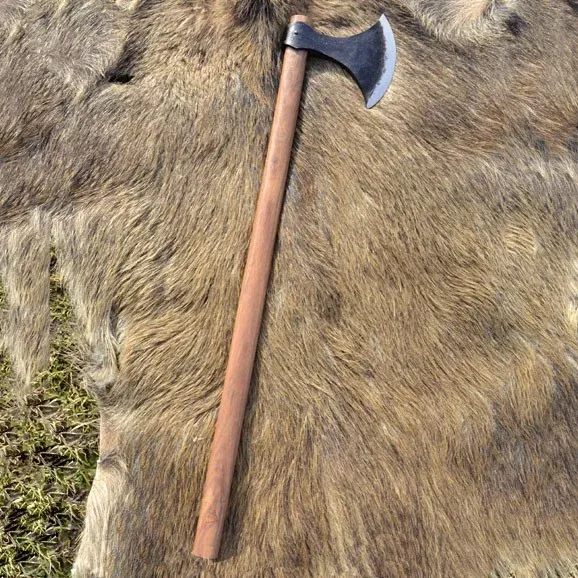
The Legacy of the Danish Axe
Although its use decreased as military tactics and defenses evolved, the Danish Axe has left an indelible mark on military history. It remains a fascinating piece for historians and enthusiasts of Viking culture, who see in it not only a weapon but a symbol of the rich and complex Nordic society.
| Aspect | Description |
|---|---|
| Origin | Nordic peoples of Europe |
| Handle Length | 120 cm - 180 cm |
| Blade Width | Approximately 30 cm |
| Material | Hard Iron |
| Uses | War, religious rituals |
The Danish Axe is a true testament to the ingenuity and skill of the Nordic peoples, representing the balance between functionality and symbolism. Its legacy endures, evoking images of epic battles and adventurous journeys through the mists of time.
Slings have been an integral part of human history, standing out as one of the oldest known weapons. They not only testify to the ingenuity of our ancestors, but their elegant and simple design has endured for centuries. This article explores in detail the structure, origin, evolution, and various uses of the sling throughout time.
Structure and Functioning of the Sling
The sling consists of a simple yet effective structure: two cords or straps with a flexible pouch used to launch projectiles. During use, the projectile is placed in the pouch, and the user swings the sling to generate speed. By releasing one of the cords, the projectile is released, achieving great distances and causing a considerable impact on the target.
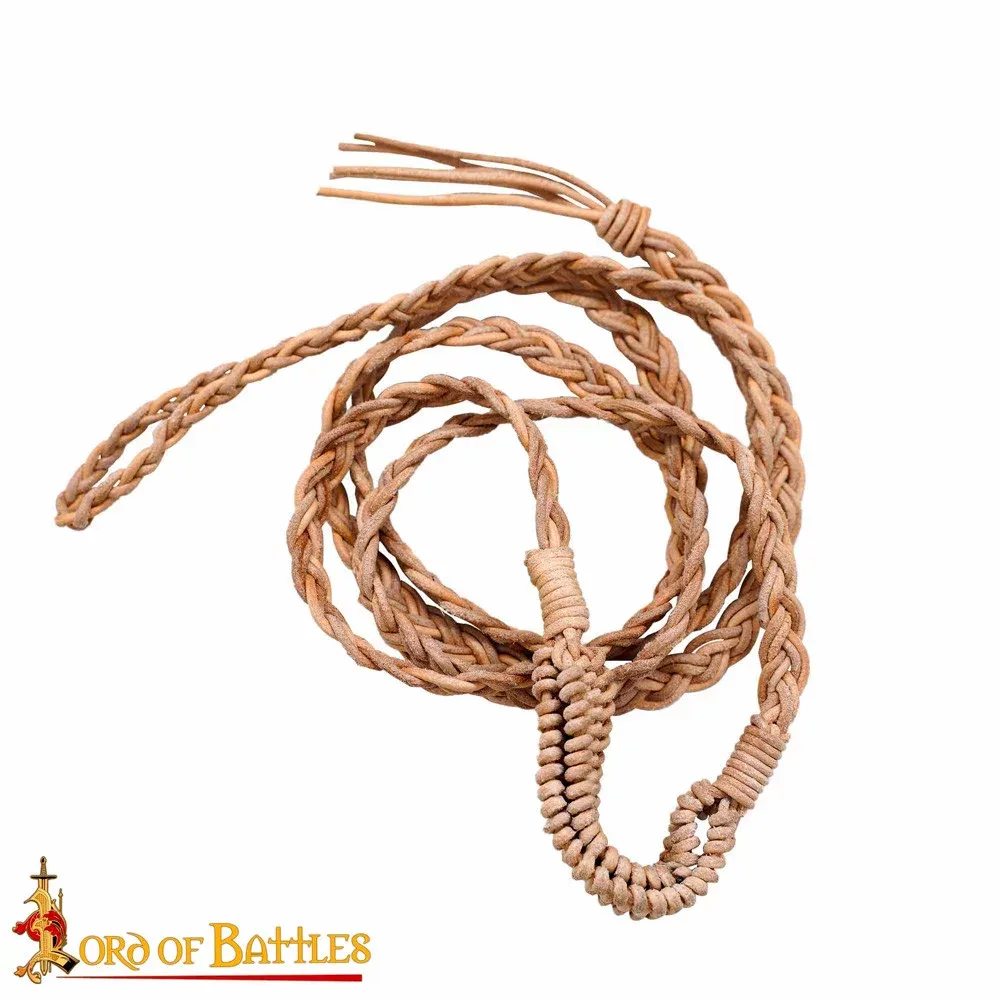
Origin and Evolution
The use of slings dates back to prehistoric times, probably at the end of the Paleolithic. Originally employed as a hunting weapon, the most consolidated archaeological evidence appears in the Neolithic, especially in the Near East. During this time, numerous projectiles made of fired clay have been discovered, suggesting their use in military conflicts in addition to hunting.
Use in Antiquity
Slings played a prominent role in the military realm of Classical Antiquity, used by civilizations such as the Greeks, Carthaginians, and Romans. Balearic slingers became legendary, hired as mercenaries due to their skill in handling the sling. These experts were trained from a young age and were known for their accuracy and power, qualities that allowed them to even penetrate armor.
Use in the Middle Ages
With the changing times, the Middle Ages brought the coexistence of the sling with innovations such as the first cannons. Although the effectiveness of the sling decreased in the face of metal armor, its simplicity and accuracy continued to be useful in sieges and battles that required a superior range.
.webp)
Cultural and Historical Contexts
Beyond the military sphere, the sling was used as an efficient tool for hunting and protecting against predators, widely employed in Mediterranean regions. Shepherds utilized it due to its low cost and effectiveness, and their skill in using the sling developed from an early age.
Notable Historical Examples
A significant example of the use of the sling can be found in Xenophon's work Anabasis, where it is narrated how a group of slingers, recruited in Rhodes, was able to confront Persian archers. This account highlights the strategic superiority of slingers in specific military situations.
Comparative Table of Slings in History
| Period | Main Use | Projectile Material | Example |
|---|---|---|---|
| Prehistory | Hunting | Stone | Archaeological remains |
| Antiquity | Military | Fired clay | Balearic Slingers |
| Middle Ages | Sieges | Stones / Metal | Medieval chroniclers |
| Pastoral Context | Protection of Herds | Stones | Mediterranean |
Over time, the sling has proven to be more than just a simple weapon; it has been a versatile tool used by various cultures in different eras. From its early uses in hunting to its strategic deployment in battles, the sling remains one of humanity's most emblematic weapons.
When discussing sieges and the complex tactics of ancient and medieval warfare, the battering ram stands out as an iconic and fundamental tool. This powerful siege instrument played a crucial role in military history, employed to dismantle the solid defenses of fortifications and castles. Below, we explore its characteristics, history, and the context in which it was used.
Characteristics of the Battering Ram
- Origin and Design: The term "battering ram" comes from the Latin aries, meaning "ram." This is because originally a ram's head was placed at the tip of the battering ram, thereby increasing the damage inflicted on the target through the animal's horns. The main structure of a battering ram consisted of a long, heavy beam, often reinforced with metal at the end. This design allowed a team of soldiers to handle it and apply force to the target.
- Operation: The operation of the battering ram required precise coordination among soldiers, who would repeatedly strike it against doors, walls, or other barriers. The goal was to weaken the defenses of an enemy fortress until significant breaches were opened.
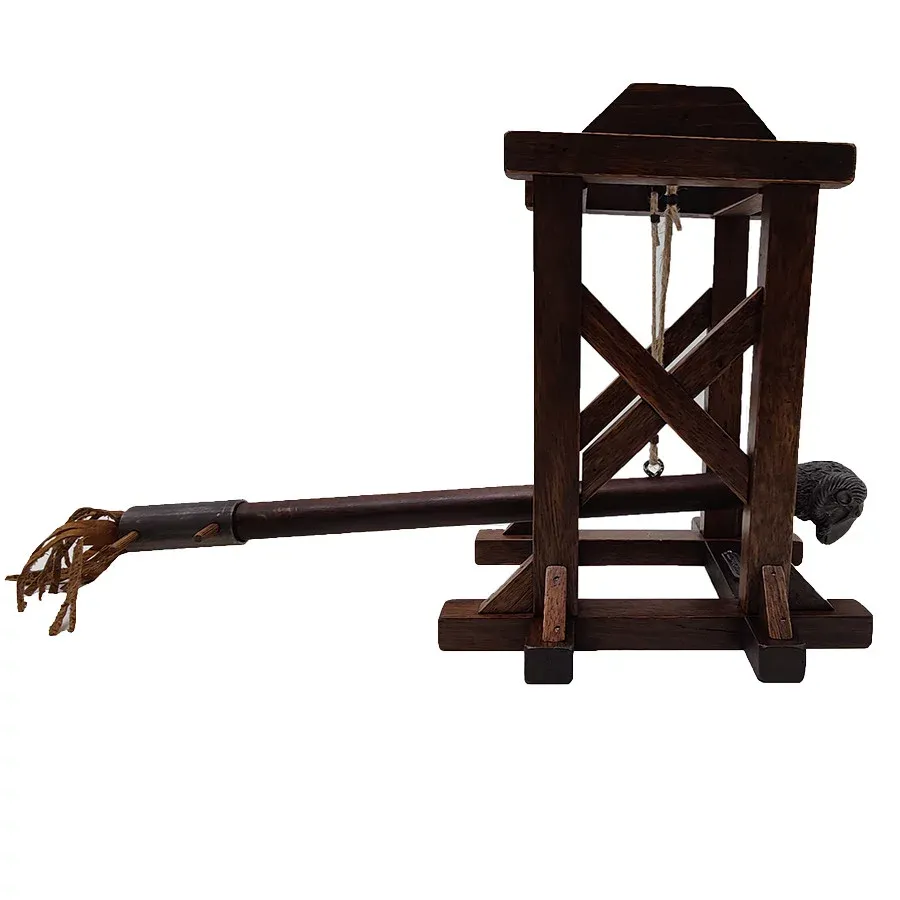
Evolution and Improvements
- Over time, battering rams were enhanced with bronze or iron coverings to increase their effectiveness. They also included leather protections to counter incendiary attacks from fortress defenders. Defense tactics evolved to incorporate obstructing battering rams before impact.
History of the Battering Ram
- Ancient Origins: The battering ram has its roots in ancient Mesopotamia, around 3500 B.C., being one of the oldest recorded siege tools. It was adopted and adapted by civilizations such as the Greeks and Romans, who developed massive structures to amplify the battering ram's impact.
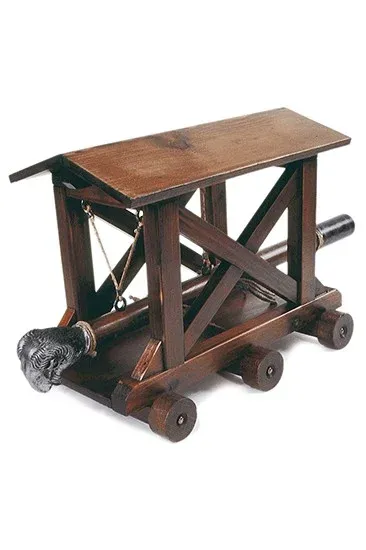
Evolution Over Time
- During the Middle Ages, European armies perfected the design of the battering ram by adding protective covers and metal reinforcements against boiling oil and projectile attacks. Even with the advancement of siege technology, the battering ram remained relevant until new tactics and armaments made it obsolete.
Use in Sieges
- Siege Tactics: Soldiers used the battering ram to strike repeatedly, weakening defenses until penetrating enemy fortifications. To protect those operating the battering ram, structures such as siege towers and tortoises were built to provide defense against attacks from above the walls.
Medieval Context: Fixed and Mobile Rams
- Fixed Rams: These were static structures focused on the constant use of inertia to destroy doors or walls.
- Mobile Rams: They offered greater flexibility on the battlefield by being mounted on a rolling frame or using a sling to facilitate retreat after impact.
| Type of Battering Ram | Main Features |
| Fixed Ram | Maintained in one place, requiring coordination of soldiers to optimize its continuous impact. |
| Mobile Ram | Mounted on wheels, allowing mobility to advance or retreat after the strike. |
A battering ram is more than just a simple demolition tool; it is a testament to ingenuity and strategy in ancient warfare machinery. Although its use has become history, its impact on the military field makes it an important chapter within siege tactics.
The catapult has been, for millennia, one of the most iconic war instruments and was widely used to launch large and heavy projectiles, such as stones and arrows, at enemy fortifications. These ingenious machines not only transformed the art of war but also symbolize a milestone in ancient and medieval engineering.
Origins and Development of the Catapult
The origin of catapults dates back to ancient Greece, specifically during the reign of Dionysius I of Syracuse around 400 B.C. Its invention marked a crucial point in military tactics. Later, the Carthaginians and Romans perfected these devices, turning them into essential tools for their military conquests.
Types of Catapults
Over the centuries, different types of catapults were developed, each with its own technological innovations:
- Torsion Catapults: They used strings made from animal tendons which, when twisted, stored kinetic energy. Upon release, the string would propel the throwing arm.
- Counterweight Catapults: They relied on a heavy counterweight that, when dropped, released a great force to the throwing arm, launching the projectile towards the target.
- Portable Catapults: These were smaller and lighter versions, employed for operations where mobility was crucial.
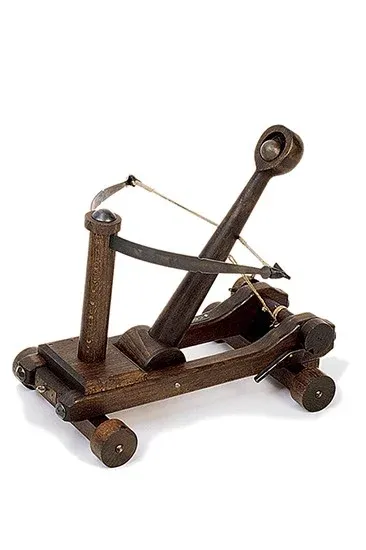
Use in the Middle Ages
In the Middle Ages, catapults continued to be a key tool in sieges. The Romans employed these devices during their extensive military campaigns with great efficacy. The larger models required wooden platforms to operate, while the smaller, portable ones allowed for use in various terrains.
Historical Examples of Catapult Usage
Catapults played a vital role in several iconic historical events:
- Siege of Motya (397 B.C.): The Greeks used catapults to conquer this Carthaginian fortress in Sicily.
- Siege of Perinthus (340 B.C.): Philip II of Macedon employed catapults during the siege in Thrace, consolidating his power in the region.
- Siege of Stirling Castle (1304): Edward I deployed a giant trebuchet nicknamed "Warwolf," which was decisive in breaching an important section of the castle wall.
Technical Innovations
Over time, engineers sought to increase the accuracy and efficiency of catapults. A notable example is the design by Leonardo da Vinci, who proposed a model that integrated a large wooden crossbow to enhance propulsion. Although his design was not realized in his time, it has been reconstructed by modern enthusiasts.
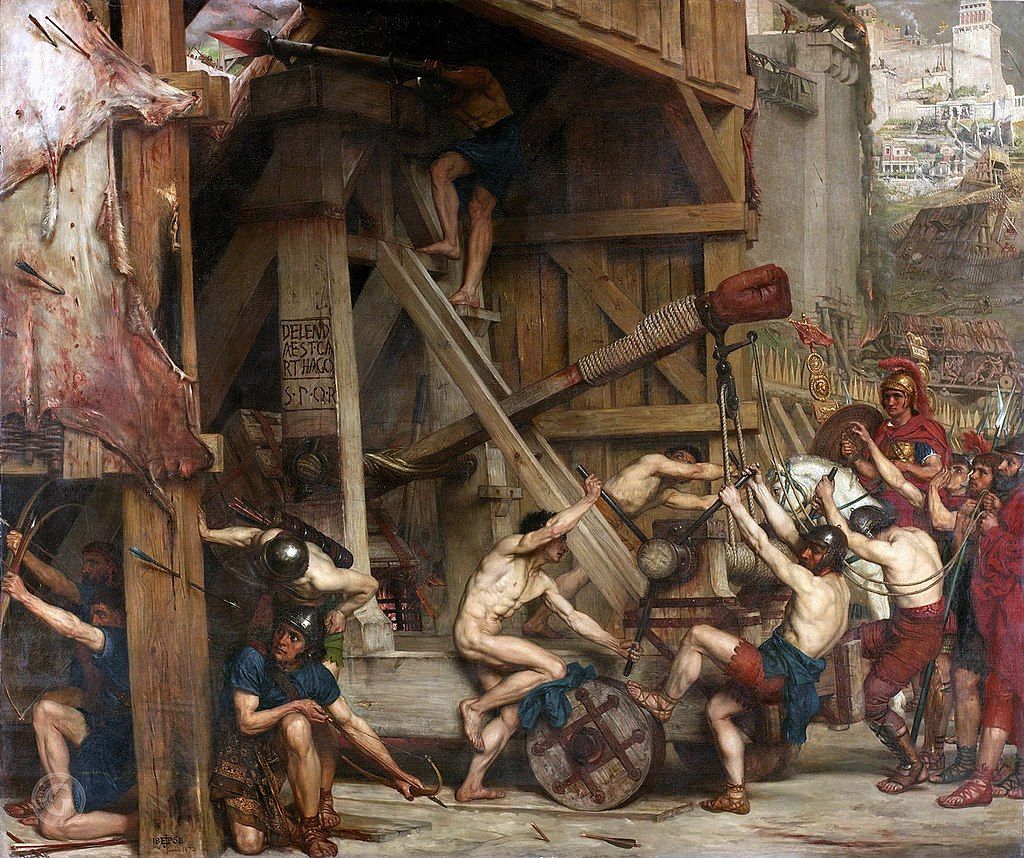
Edward Poynter, Public domain, via Wikimedia Commons
Although the advent of gunpowder marked its obsolescence as an effective war tool, catapults remain an emblem of engineering and military strategy from past times, reminding us of the inventiveness and skill of the ancients in the art of combat.
The blunderbuss is a historical firearm, particularly known for its muzzle-loading design. With its short barrel and a characteristic flared mouth, the blunderbuss is a predecessor of the modern shotgun, adapted for both military and defensive services. Its emergence dates back to the 17th and 18th centuries, periods during which it consolidated itself as an effective weapon in various combat situations.
Origins and Characteristics of the Blunderbuss
The blunderbuss appeared in the 17th century, gaining popularity throughout Europe in the 18th century. The term "blunderbuss" comes from the Dutch word "donderbus", which means "thunder pipe." This weapon is characterized by a barrel that typically measures less than 60 cm and has a flared mouth. This unique structure facilitates the introduction of multiple projectiles, making it effective in close combat.
Design and Functioning
The use of the blunderbuss involved a meticulous process of loading through the barrel's mouth. This procedure began with the introduction of black powder and wadding, followed by the ammunition, often shot pellets. All the contents of the barrel were compacted using a ramrod. Subsequently, fine powder was added to the touch hole of the weapon, connecting with the main charge via the blunderbuss's touch hole, allowing it to fire when the mechanism was activated.
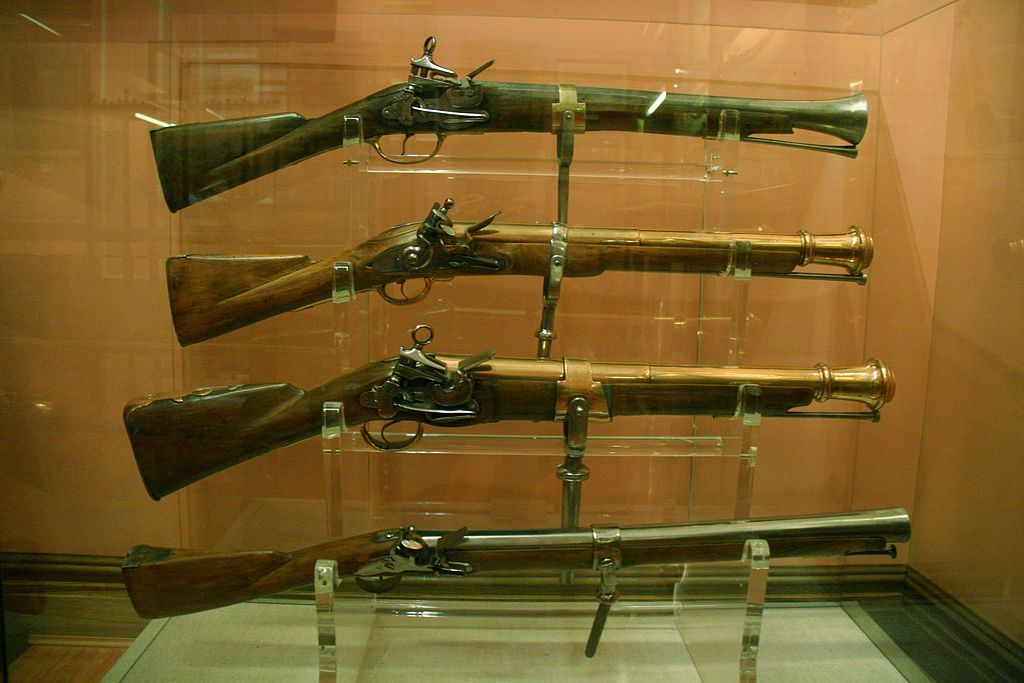
Tamorlan, CC BY 3.0, via Wikimedia Commons
Historical Use of the Blunderbuss
This weapon was widely used in hand-to-hand combat and during naval boarding actions. Its effectiveness lay in its ability to launch multiple projectiles, making it deadly at close range. Soldiers, sailors, and privateers frequently used it in warfare due to its broad dispersion capability, which was practical in situations where they faced multiple adversaries.
Importance in Medieval Warfare
In a medieval context, the blunderbuss offered clear advantages on the battlefield. The ability to hit several opponents at close range made it a valuable resource for both infantry and naval forces. Its utility was evident in confrontations against armored troops or in direct engagement with large groups of enemies.
Limitations of the Blunderbuss
Despite its advantages in certain combat situations, the blunderbuss presented some limitations. Its design with a short barrel hampered accuracy at long distances, and although its wide dispersion was effective for hitting multiple targets, it was less efficient against adversaries with heavy armor.
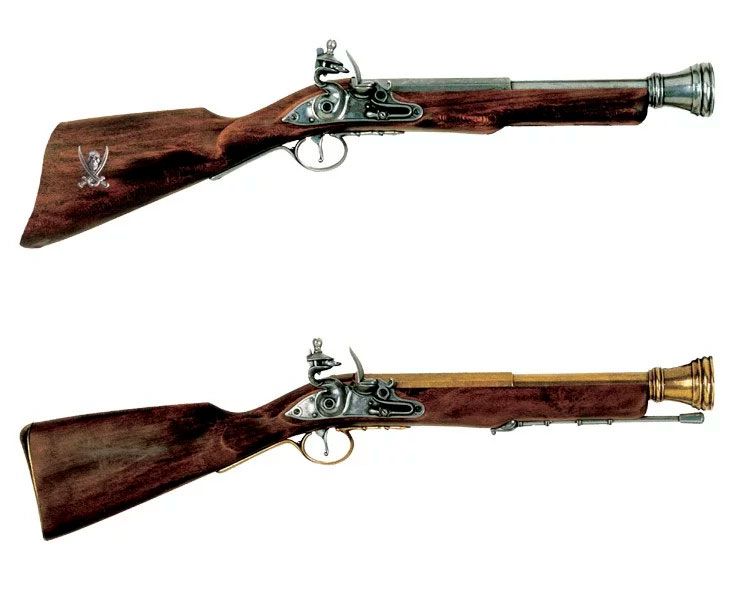
The Morning Star is a fascinating medieval weapon that arouses the interest of history scholars and enthusiasts of the medieval period. Also known as *Lucero del Alba* in Spanish and *Morgenstern* in German, this weapon stands out for its distinctive design and effectiveness on the battlefield. Below, we will explore its characteristics, history, and differences from other medieval weapons in detail.
Origin and Evolution of the Morning Star
The Morning Star has its roots in the Middle Ages, specifically in the 14th century. Although it initially emerged as a rudimentary combat tool, its design evolved over time to become more effective in warfare. Initially, it consisted of a club with a spherical metal head studded with spikes, giving it devastating power in combat. As time progressed, it was adapted to better penetrate enemy armor and defenses.
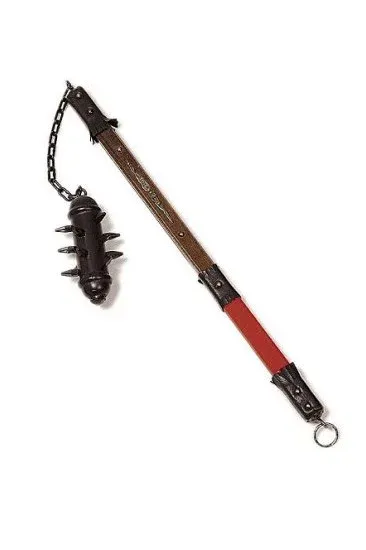
Distinctive Characteristics
- Armored Head: The central piece of the Morning Star is its armored head, composed of a metallic sphere, also known as an iron or lead sphere. Sharp spikes protrude from this sphere, maximizing damage upon striking.
- Morphology: Along its circumference, the spikes are strategically distributed, making the Morning Star an advanced version of a primitive club that provides both impact strength and piercing capability.
- Military Use: Designed to face plate armor, shields, and other medieval defenses, it was highly effective as a striking and grappling weapon, providing an advantage in close combat.
History and Use in Warfare
During the Middle Ages, the Morning Star became a favored weapon in the Iberian Peninsula and other regions of Europe. Its effectiveness and the fear it instilled in the enemy made it a subject of mention in numerous combat skill treatises in Spanish, French, and English, highlighting its relevance in military arsenals.
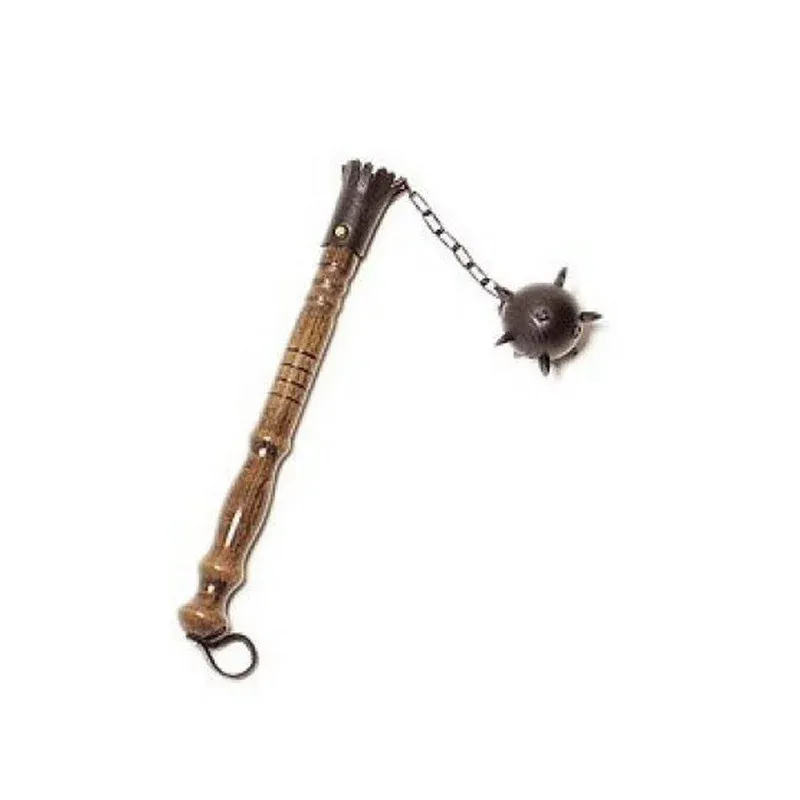
In the heat of battle, its ability to inflict deep wounds was reinforced by the risk of severe infections, a threat as real as the physical confrontation itself. Additionally, its intimidating appearance contributed to demoralizing its opponents, demonstrating that the psychological impact in war is as crucial as the physical one.
Differences with the Flail
It is common to confuse the Morning Star with the Flail due to their similarities. However, there are notable differences between the two:
- Flail: It has a chain connecting a round spiked mace to a wooden handle. This flexibility allows for a smoother and potentially more unpredictable movement in attack.
- Morning Star: This weapon lacks a chain, offering a more controlled and direct strike. Its rigid and blunt structure distinguishes it as a more stable attack means and less prone to self-injury during use.
| Element | Morning Star | Flail |
|---|---|---|
| Presence of Chain | No | Yes |
| Type of Strike | Blunt and controlled | Unpredictable |
| Structure | Rigid | Flexible |
This peculiar and powerful instrument of war is further proof of medieval ingenuity and the advancement of personal artillery during the Middle Ages, an era that continues to fascinate, igniting the imagination about how wars and battles shaped the destiny of entire nations.
The musket is an iconic firearm that left its mark on military history between the 16th and 19th centuries. Recognized for its muzzle-loading technique, the musket served as an evolution of the more primitive arquebus. This advancement allowed for greater effectiveness and precision in the confrontations of the time, as well as a considerable influence on the military strategy of major powers. Below, we will explore in detail its origins, the firing technologies it implemented, its distinctive characteristics, and its crucial role in the conflicts of those times.
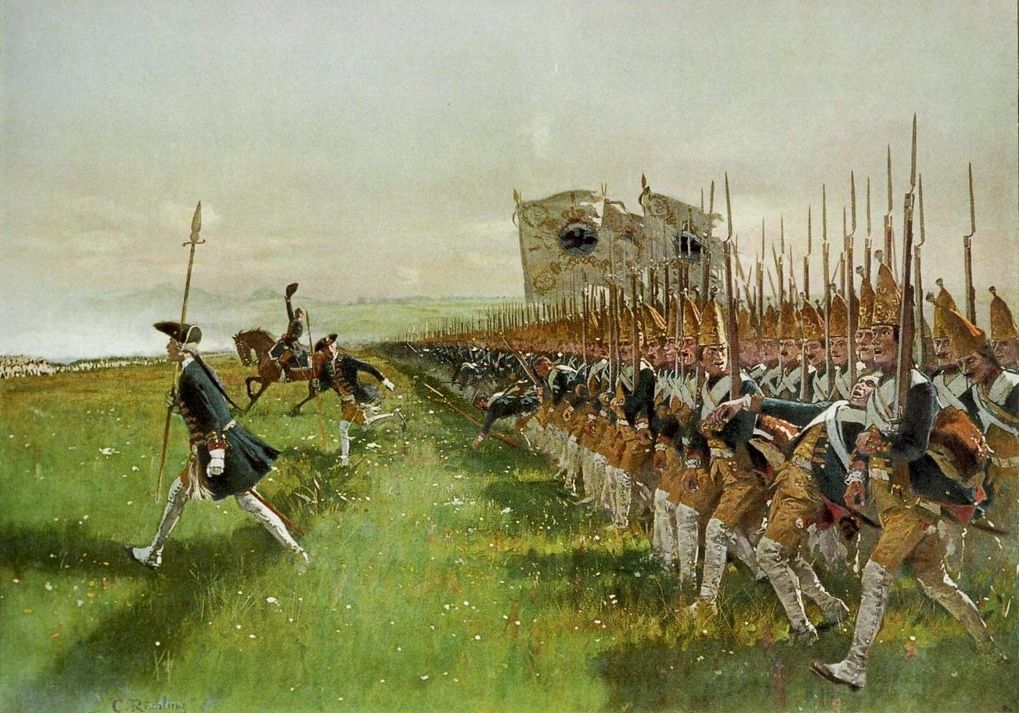
Origins and Development
The musket originated as an innovation over the arquebus, offering significant improvements that altered the course of armed confrontations. The first musket designs were developed in Dresden, Germany, introducing a new method for igniting the fuse using a flint against a rough steel surface. This technique allowed the weapon to be fired more easily and reliably. As the musket was refined, new technologies were incorporated to enhance its effectiveness and safety.
Firing Technologies
The development of the musket included various firing technologies, each building on the achievements of its predecessor:
- Matchlock: The most rudimentary system, involved manually igniting a fuse before bringing it close to the gunpowder.
- Wheel Lock: Introduced in 1515 in Germany, it replaced the fuse with a gear mechanism that generated sparks using a flint.
- Flintlock: A flint struck against a piece of steel to create the sparks necessary to ignite the gunpowder.
- Percussion Cap: This modern technology used an explosive cap to fire, although it was not commonly adopted in muskets.
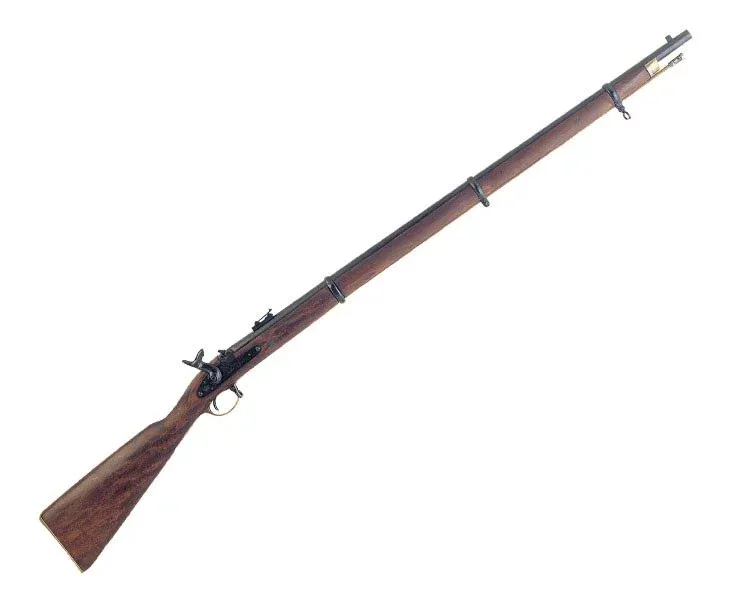
Characteristics and Use
The musket was characterized by being a weapon of considerable size and weight, often requiring the support of a fork for effective aiming. Its barrel could reach up to one and a half meters in length, firing heavier bullets than those of the arquebus, which increased its stopping power. In combat, musketeers were organized into tactically innovative formations, firing in volleys to maintain continuous fire.
Impact on War
During the 17th and 18th centuries, the impact of the musket on warfare was significant. Formations of musketeers protected by pikemen formed an almost insurmountable barrier against enemy cavalry units. Infantry soldiers armed with muskets could fire in a coordinated manner, annihilating cavalry with devastating effectiveness. This tactical system became an essential part of military operations of the time.
In conclusion, the musket was not only a technological evolution in infantry weaponry but also a driving force in the tactical developments of modern warfare. Its legacy is palpable in the military strategies that continued to evolve over the centuries.
A key element of artillery in ancient times, the Onager is a type of catapult that was used in numerous sieges due to its ability to launch projectiles over great distances. The name comes from the Latin "onager," which means "wild ass," referring to the force with which these animals kicked, similar to the impact produced by the Onager when releasing its projectiles.
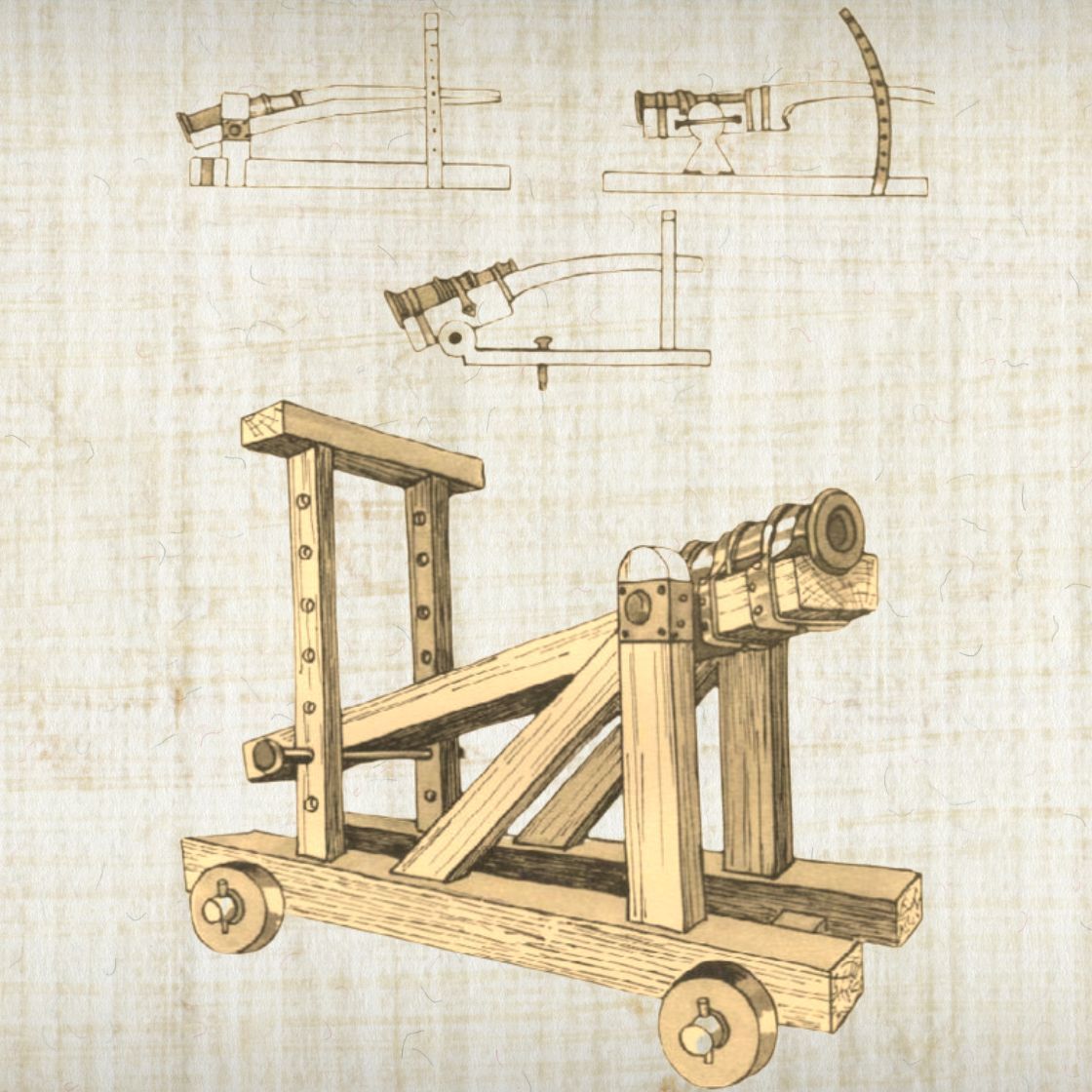
History and Origins
The Onager was first used by the Roman Empire around 200 BC. Its first recognized mention is found in the writings of the Greek Philo, followed by references from Apollodorus a century later. However, detailed descriptions began to appear until the 4th century, when historians such as Vegetius and Ammianus Marcellinus extensively documented its design and application.
Design and Functioning
A notable innovation of its time, the Onager consisted of a sturdy frame that held a long arm made of woods such as ash or oak. To ensure the reliability of the arm, it was preferred to be free of knots. This arm was tensioned using fibers from plant or animal sources, particularly tendons, known for providing greater power to the machine.
Shooting Mechanism
The firing action involved the use of a winch with iron bars that pulled the arm back. Once tensioned, it was held in place by a catch that, when released, abruptly freed the arm. Upon hitting its padded stop, a solid sack filled with straw, the projectile was launched, functioning similarly to a sling.
Variations of the Onager
The Onager was not uniform in its design but featured variations depending on the specific purpose in warfare. Some versions incorporated a spoon at the end of the arm to launch incendiary projectiles, while others had wheels, facilitating the movement of the device. Its sizes also varied: from portable models operated by four men to large structures capable of firing enormous rocks over distances exceeding 250 meters.
Battlefield Applications
The Onager played a fundamental role in sieges, breaching enemy walls and demolishing fortifications. Its use was not limited solely to land campaigns; it was also deployed in Roman naval battles, allowing effective attacks from the decks of warships and significantly contributing to the military strategy of classical Rome.
The Effective Simplicity of the Onager
Despite its simplicity, the Onager represented an extremely effective piece of artillery. Generally manned by a group of eight men on earth or brick bases to minimize the impact of vibrations, the Onager reflects one of the many ingenious ways ancient civilizations developed to enhance their effectiveness in military campaigns.
The impressive legacy of the Onager is marked not only by its advanced engineering for the time but also by its lasting impact on the art of siege warfare and the evolution of military weapons in ancient times.
The ballista, also known as balista, represents one of the most important siege inventions of antiquity, and its impact on the evolution of military tactics is still a subject of study and admiration today. These devices were created to launch large projectiles over long distances, primarily during times of war, essentially designed to besiege fortifications and apply pressure on opposing armies.
Origin and Evolution of the Ballista
The ballista was initially developed around 400 BC thanks to the ingenuity of Dionysius I of Syracuse, refining earlier mechanisms like the oxybeles and the gastraphetes. Its innovative design was later optimized under the leadership of Philip II of Macedon and his son Alexander the Great, who introduced substantial improvements, such as the use of springs made from tightly wound rope coils, which gave the weapon greater power and efficiency in launching its projectiles.
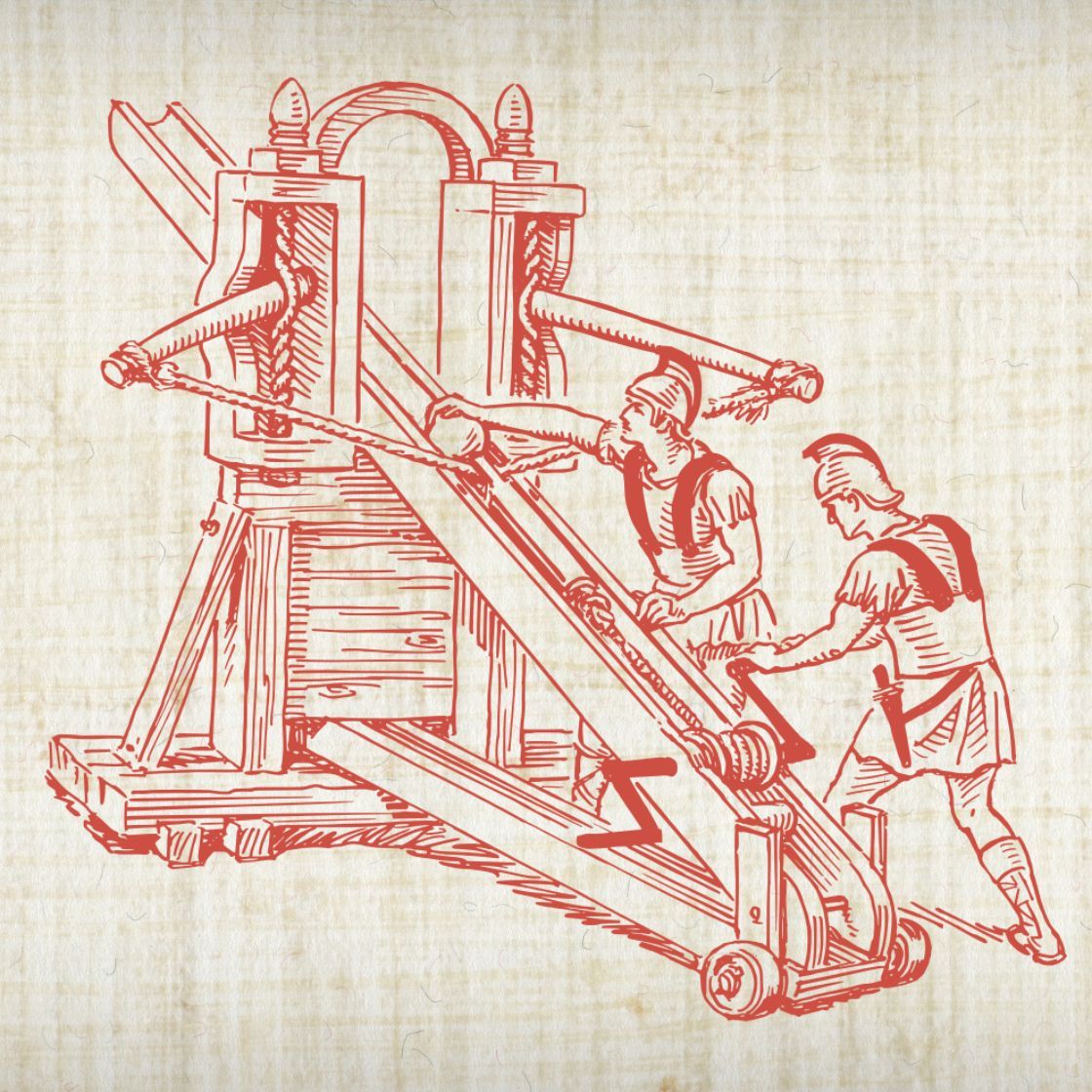 Pearson Scott Foresman, Public domain, via Wikimedia Commons
Pearson Scott Foresman, Public domain, via Wikimedia Commons
Main Features and Operation
The ballista operated with a mechanism similar to that of a crossbow, but adapted to a larger size to allow for the launch of darts or stone spheres over distances exceeding one hundred meters. Unlike smaller devices, the massive size of these weapons allowed for powerful projection, destroying garrisons at significant distances.
- Projection Capacity: Its structure allowed for the launch of heavy projectiles, useful for piercing defenses in fortified walls.
- Construction: Mainly made of wood, the ballistas were held together by iron plates and rivets, with a complete mechanism of winches and claws to reload the string and prepare for firing.
Use in Historical Conflicts
During antiquity, the ballista was strategically employed in significant military events, such as the Second Punic War, where smaller versions, known as scorpions, were also used. These weapons allowed for adjustments to their mechanisms to fire different types of projectiles, ensuring adaptability on the battlefield.
Differences with the Crossbow
Both the crossbow and the ballista share basic similarities, such as the use of a tensioned bow; however, the crossbow is much more compact and portable compared to the massive ballista. The latter was a siege tool, whereas the crossbow, originating in ancient China, spread throughout Europe and Asia, primarily as a handheld weapon during the Middle Ages.
Impact and Legacy of the Ballista
The role of the ballista in the evolution of artillery cannot be underestimated. Its construction and design secured its place as a key piece in military history, influencing later developments until the arrival of firearms, such as arquebuses and muskets. Although it eventually fell into disuse, its essence remains in modern forms used in sports and hunting, keeping alive a tradition of tactical engineering.
| Differences | Crossbow | Ballista |
|---|---|---|
| Size | Compact, portable | Large, stationary |
| Projectiles | Small arrows | Heavy darts, stones |
| Use | Individual handheld weapon | Siege mechanism |
| Origin | China, 5th century BC | Greece, 4th century BC |
The ballista, as a testament to innovation in ancient warfare, offers crucial lessons on the evolution of weaponry and the strategies that allowed past civilizations to consolidate their domains and expand their borders. Its legacy transcends time, serving as a clear example of human genius and adaptability in times of conflict.
The Borre Viking style is an artistic manifestation that developed during the Viking Age, approximately from the second half of the 9th century to the end of the 10th century. This style is one of the most distinctive features of Scandinavian decorative art and originated from findings in the Borre cemetery in Vestfold, Norway. Discoveries in this area, particularly the harness fittings of a funeral ship, have allowed the identification and characterization of this unique style, which can be found in various regions, reflecting the extensive influence and contacts of the Vikings during their travels.
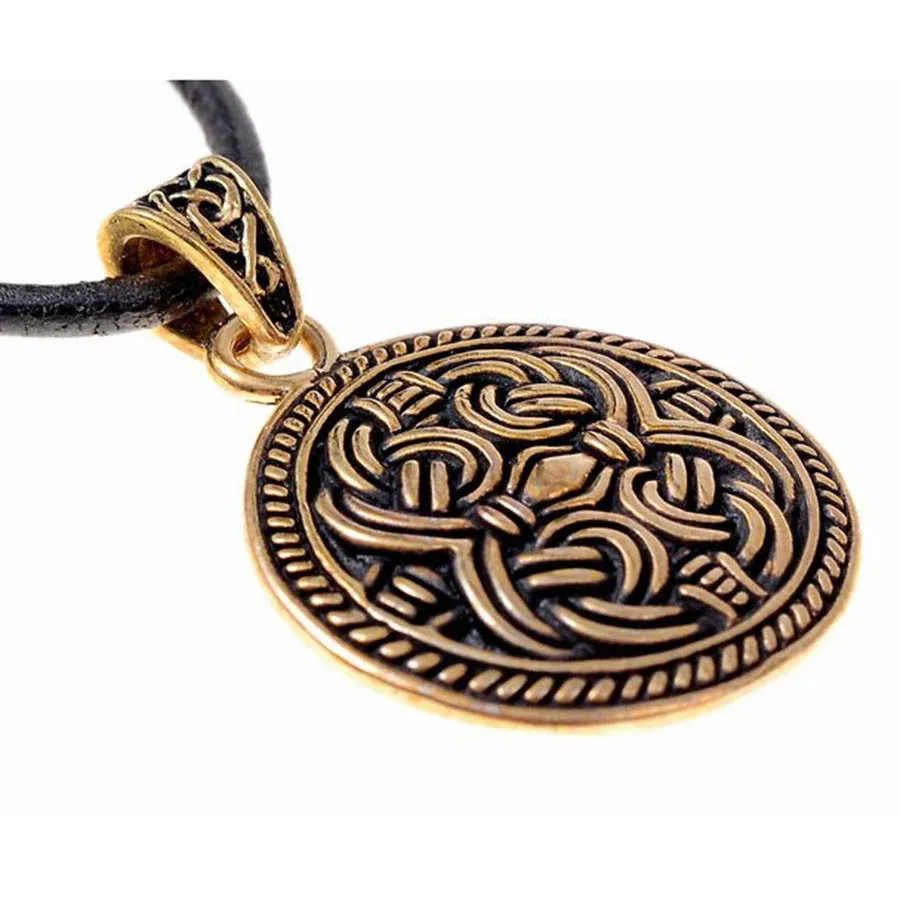
Main Features of the Borre Style
- Zoomorphic Motifs: The most prominent characteristic of the Borre style is the use of stylized animals, generally represented head-on, with elongated bodies resembling ribbons. These figures often have polygonal hips and features of "gripping beasts", whose limbs seem to hold other elements of the composition, creating a visual effect of wrapping or enclosing themselves.
- Geometric Patterns and Closed Compositions: The style emphasizes the use of space, completely covering it with decorations. These dense compositions often include intertwined bands that simulate chains or braids, known as "double ring-chain", creating repetitive and symmetrical patterns.
- Technical Details: It is notable for its skill in filigree and granulation, showcasing meticulously worked details that often imitate filigree wire in metal designs.
- Innovations Regarding Previous Styles: Although the Borre style is based on the heritage of the Oseberg style, it incorporates greater complexity in the motifs and emphasizes symmetry and the use of continuously decorated space.
Areas of Use and Examples
- This style was primarily applied to metal objects such as brooches, buckles, belt tips, and various personal adornments. It was also used in the decoration of boats and wooden objects.
- Although many pieces were found in Norway, Denmark, and Sweden, the style spread due to trade and Viking settlements in Western and Eastern Europe.
- Today, the motifs and designs of the Borre style continue to inspire jewelry and art, reflecting the characteristic braid and silhouettes of the “captivating beasts.”
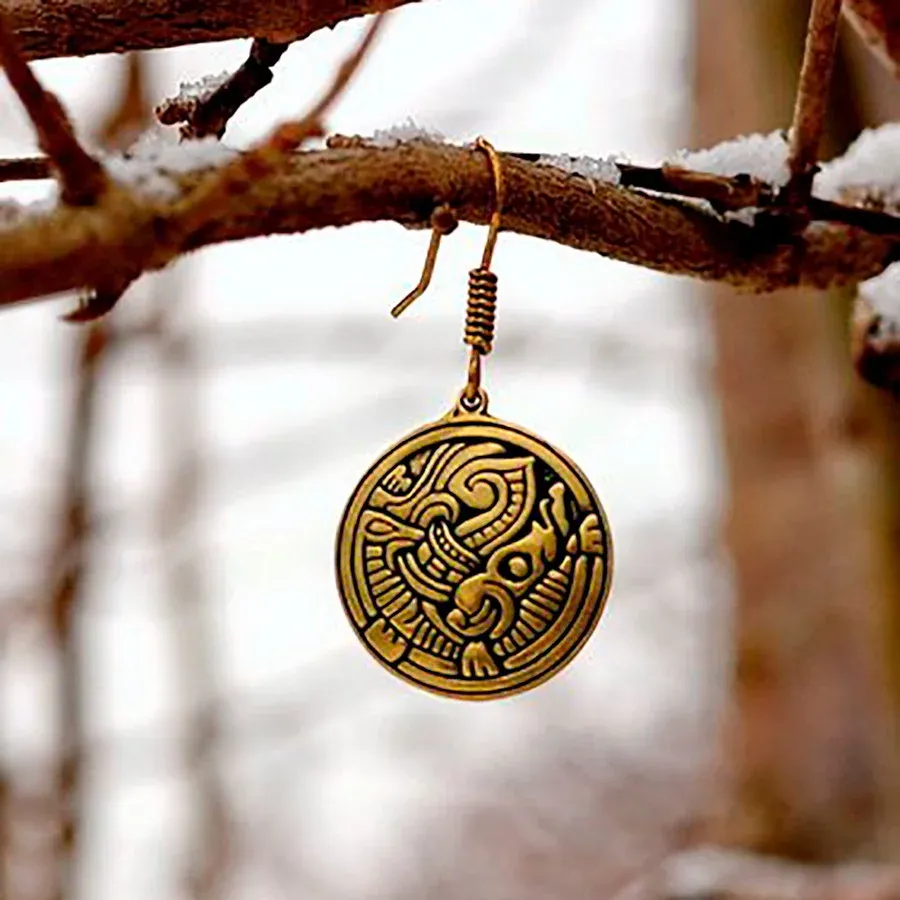
Comparison with Other Viking Styles
- In contrast to the Oseberg style, Borre presents denser and closed compositions, without open backgrounds.
- Compared to the Jelling style, which is its successor, Borre maintains front-facing and geometric animal figures while Jelling prefers more open and fluid figures.
Cultural Importance
The Borre style is crucial in the history of Viking art, as it reflects both the Nordic cultural identity and the ability of the Vikings to integrate and influence other cultures. Its repetitive patterns, symmetry, and interlaced motifs continue to be emblematic of Viking aesthetics and still inspire art and goldsmithing today.
In short, the Borre style is distinguished by its geometric complexity and decorative density, representing one of the great stages of Viking artistic creativity.
The Oseberg Viking style is a fascinating chapter in the decorative art of the ancient Viking civilization and marks the beginning of an artistic development that shaped its characteristic aesthetic. Much more than just a simple set of decorative techniques, this style reflects the cultural and historical environment from which the Vikings emerged.
Origin of the Oseberg Style
The designation Oseberg style, also known as Oseberg-Broa style, is due to two crucial archaeological finds: the famous Oseberg burial ship in Norway and the Broa grave in Sweden. Both sites, dated from the late 8th century to the early 9th century, have made a valuable contribution to our understanding of Viking art by preserving extraordinary objects made of wood, metal, and textiles, many of which remain in remarkably good condition.
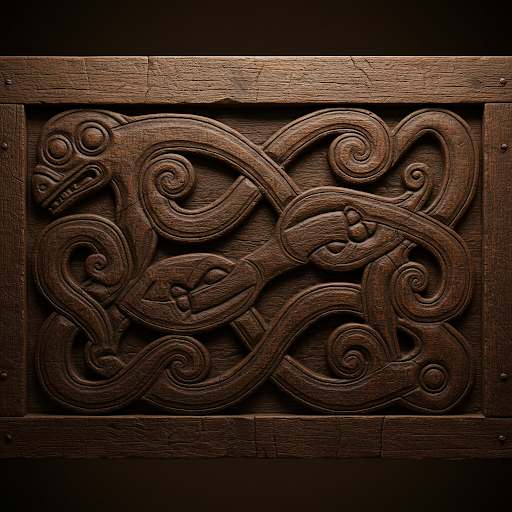
Characteristics of the Oseberg Style
One of the most representative characteristics of the Oseberg style is the presence of beast figures with indeterminate anatomy. These creatures, with sinuous bodies, are adorned with spiral-like projections and prehensile limbs. The latter element is particularly important as it symbolizes the "gripping beast motif," a distinctive element that persisted in Viking art for approximately 150 years. These decorations were not limited to luxury items: they also adorned everyday objects such as bed frames, horse bridles, and wood from the burial ship.
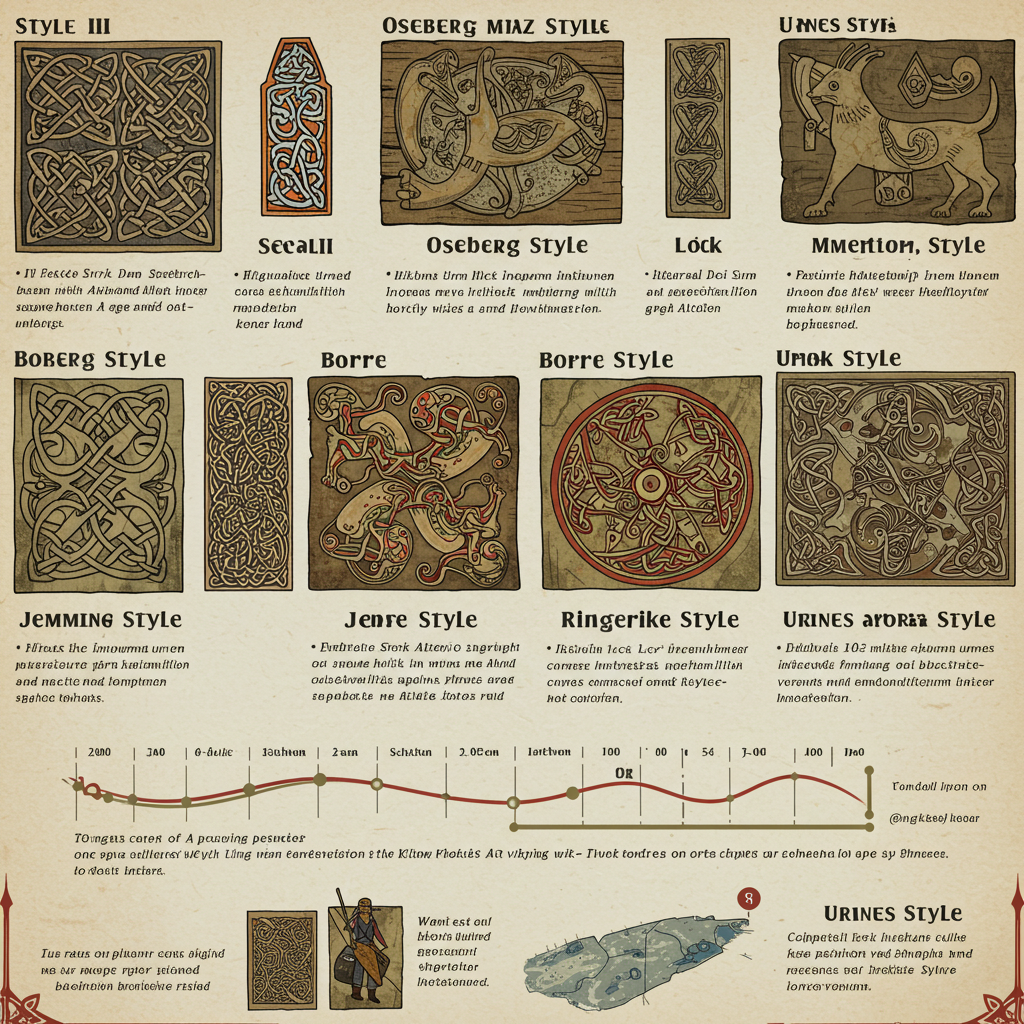
Historical Context
The Oseberg style developed around the years 780 to 850 AD and marks the beginning of Viking art, allowing the transition from the artistic tradition of the Vendel period to purely Viking styles. This style was essential in laying the foundations for later styles such as Borre, Jelling, Mammen, Ringerike, and Urnes, each evolving with its own influences but inheriting the animalistic and geometric elements of Oseberg.
Impact and Legacy
The discovery of the Oseberg grave is one of the most significant archaeological contributions from the Viking world, offering not only a beautiful collection of carved wooden objects but also remarkable textiles. These discoveries provide us with a comprehensive perspective on Viking art across various materials, demonstrating the intricate creative work of the craftsmen of the time.
The Oseberg style not only lays the groundwork for Viking decorative art but also offers a window into the Viking mindset and culture, where animal and symbolic figures carried mythical meanings, likely for protection and religious symbolism.
Visual Summary and Key Features
- The style developed between the 8th century and part of the 9th.
- Its main motifs include fantastic beasts with curved bodies, prehensile limbs, and spirals.
- It was applied to a variety of objects, from textiles to wood and metals.
- It is the first phase of Viking art, influencing subsequent styles.
- The "gripping beast motif" is its most distinctive feature.
- Named after discoveries in Oseberg, Norway, and Broa, Sweden.
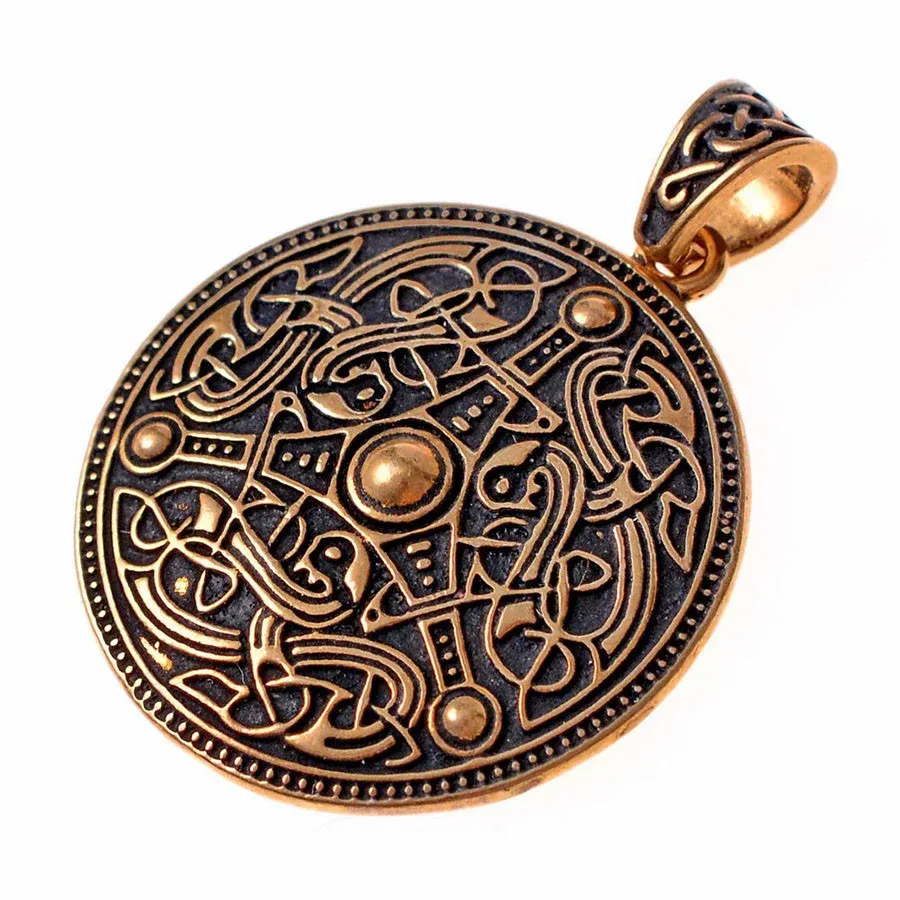
The Oseberg Viking style is fundamental for understanding the evolution of art in Northern Europe during the Middle Ages. It represents the beginning of an artistic legacy that continues to fascinate with its visual originality and symbolic richness.
The Jelling style is a crucial stage in Viking art that emerged during the 10th century, marking a significant advancement in the artistic expression of this Nordic culture. Its name comes from a silver chalice found in the royal burial mound of Jelling, Denmark. Initially, it was linked to the well-known runestones of Harald Bluetooth, although these were later assigned to the Mammen style. The Jelling style is characterized by its avant-garde, stylized, and geometric forms, reflecting a transition in the evolution of Viking art.
Characteristics of the Jelling Style
- Stylized S-shaped animals: The Jelling style is known for representing animals with elongated and curved bodies, always in profile. This elongated and sinuous design was also used to depict human figures.
- Vegetal motifs: The figures incorporated projections of vegetal shapes, such as tendrils and leaves, intertwined in complex decorations, creating a unique dynamism in the pieces.
- Geometric figures: The predominant use of circles, spirals, and triangles highlights the interest in geometric representation, demonstrating a sophistication in Viking art of the time.
Context and Evolution of the Jelling Style
The Jelling style emerged in the first half of the 10th century, coexisting with the Borre style. During this period, Viking art began to focus more on stone carving, reducing the use of wood and other traditional materials. Situated between the Borre style and the Mammen style, the Jelling style precedes and paves the way for future artistic evolutions. The pieces representing this style include various jewelry, horsebridles, and runestones found in Denmark, Sweden, Norway, England, the Isle of Man, and the Orkneys.
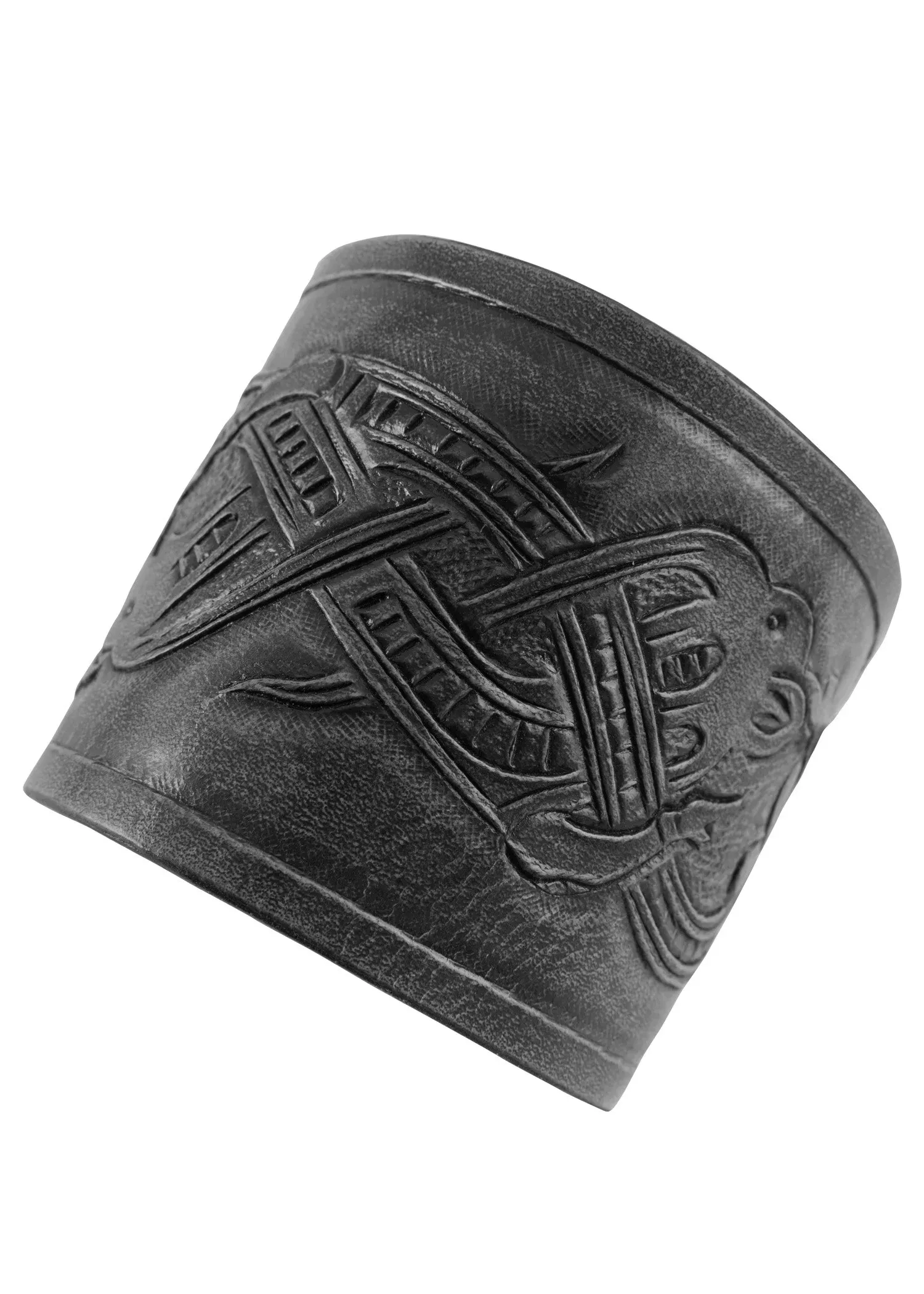
Influence and Legacy
The Jelling style is just one part of the rich Viking artistic tradition that developed over six successive styles: Broa-Oseberg, Borre, Jelling, Mammen, Ringerike, and Urnes. Each style reflects the diverse cultural and technical influences of its respective era. With its intricate ornamentation and stylized forms, the Jelling style left a lasting legacy in the development of Viking art, impacting medieval artistic production.
Today, the Jelling style continues to inspire artists and designers interested in reviving Viking traditions in contemporary creations, such as leather embossed bracelets and replicas of historical artifacts. This fusion of zoomorphic and geometric elements is a testament to the cultural and artistic splendor of the Viking age.
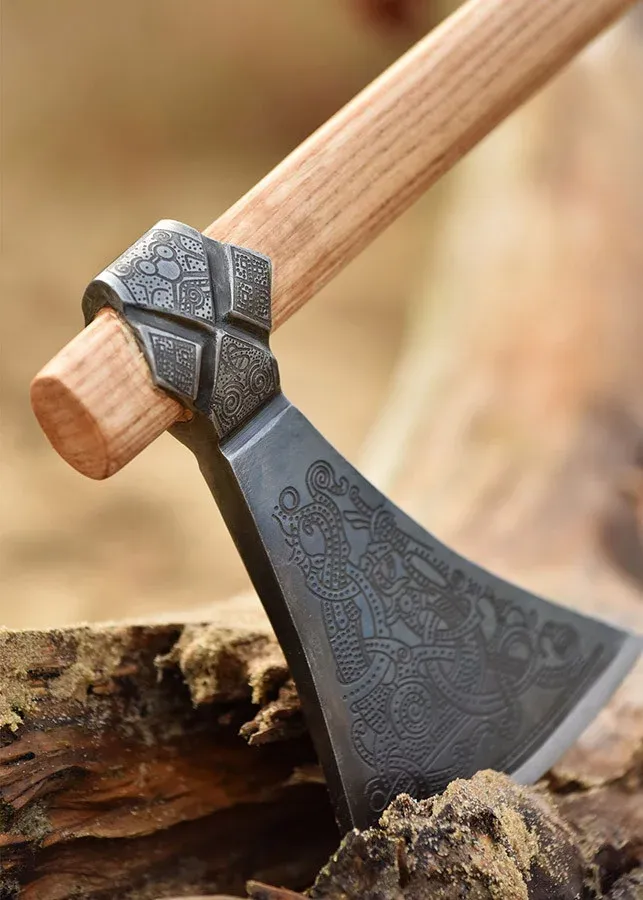
The Mammen Viking style is a celebrated manifestation of Viking decorative art that developed in the second half of the 10th century and the early 11th century in Scandinavia, particularly prominent in Denmark. This art is named after the Mammen axe, a richly decorated ceremonial object discovered in an aristocratic grave near the village of Mammen in Jutland, Denmark. This axe, along with other sumptuous objects, displays silver decorations inlaid with complex animal and plant motifs, representing the most iconic example of this artistic style.
Main Characteristics of the Mammen Style
- Animal and plant motifs: In the Mammen style, semi-naturalistic animals such as birds, lions, and serpents are prominent, accompanied by well-defined plant motifs, such as tendrils, curls, and leaves. These elements often intertwine in dynamic and asymmetric compositions, rich in turns and unexpected twists.
- European influences: Although deeply rooted in Scandinavian tradition, the Mammen style incorporates elements of Western European art, adapting them to Nordic taste. This is reflected in the use of plant volutes and wavy shapes that denote clear continental influences.
- Zoomorphic decoration: Following the legacy of earlier styles such as Jelling, the Mammen style continues to use the serpent motif but adds richness and detail with more robust and realistic animal figures. In some cases, these animals are decorated with geometric or ornamental details, as seen in the famous Mammen axe.
- Materials and techniques: Mammen style creations are found in various materials, such as silver, iron, ivory, wood, and stone. These works demonstrate the high technical level of Viking artisans, especially in inlay and precise engraving techniques.
- Geographical distribution: Examples of this style have been found not only in Denmark but also in countries such as Germany, Poland, and even the Iberian Peninsula, which evidences the wide influence of Viking art in Europe.
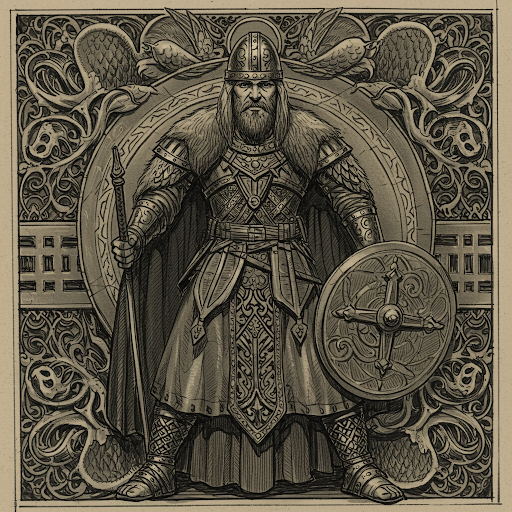
Iconic Pieces of the Mammen Style
- Mammen Axe: This ceremonial object is decorated with elaborate intertwined animal motifs and a large stylized bird. It was a symbol of status and power in its time.
- Great Jelling Stone: It stands out for introducing the "great beast" motif, a future symbol of Viking art, and for representing Christ in a stylized manner, adapting to Nordic symbolism.
- Chests from Cammin and Bamberg: These chests, crafted from ivory and other precious materials, are decorated with intertwined animals and plant motifs of the style, reflecting the artistic and decorative breadth of Mammen.
Importance and Influence
The Mammen style symbolizes the transition from early Viking art to more complex and sophisticated decorative forms that would later flourish, such as the Ringerike style. Its peak coincided with the reign of Harald Bluetooth and spread along Viking trade routes and settlements in Europe. Although its prominence was relatively short-lived, the Mammen style left an indelible mark on the history of Scandinavian and European art, reflecting the cultural richness and cosmopolitanism of Viking society at the end of the 10th century.
The Urnes Viking style represents the last elegant expression of Viking art, primarily developed during the second half of the 11th century and the early 12th century. This style is renowned for its complex zoomorphic decorations and coincides with a transitional era where Viking art was gradually influenced by the Christianization of the Nordic peoples.
Origin and Denomination
The name "Urnes" comes from the wooden church of Urnes in Norway, an iconic site identified by the archaeologist Haakon Shetelig in 1909 as the prototype of this style. This church, now protected by UNESCO due to its cultural value and its fusion of Nordic and Christian decorative elements, is a relic of great importance. The church exemplifies the transition from Nordic paganism to Christianization. However, the alternative name "Runestone style" is also noteworthy, as many of the manifestations of this style are found in runes in Uppland, Sweden.
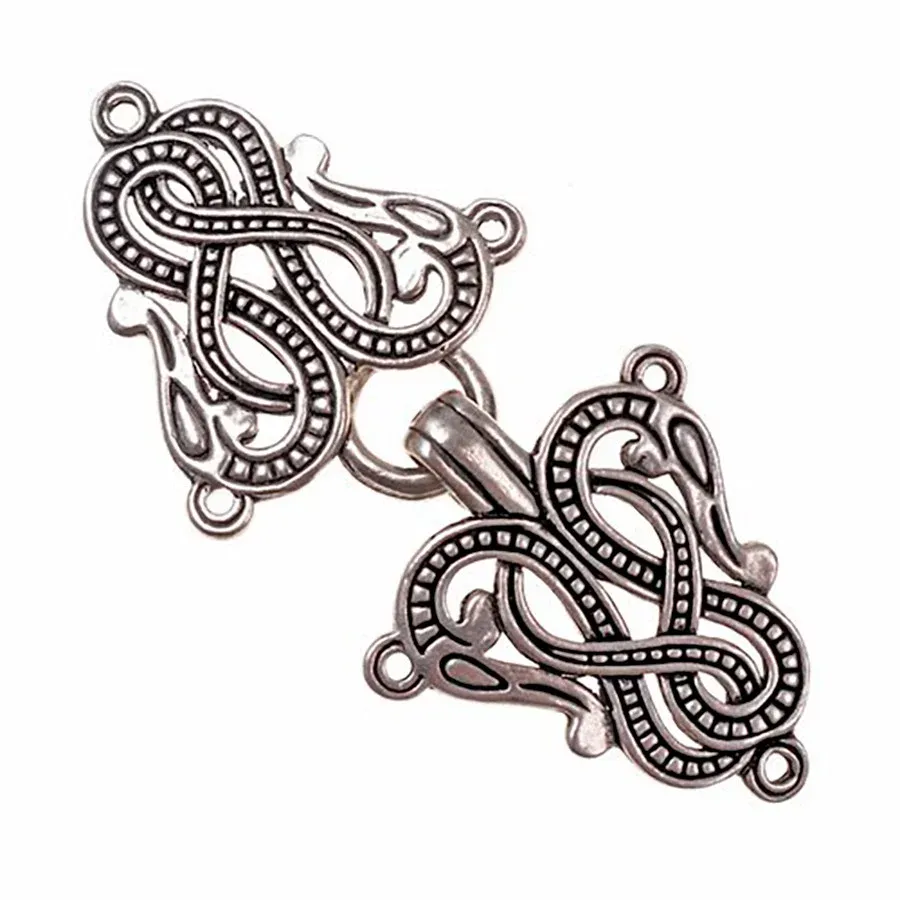
Aesthetic Characteristics
The Urnes style is distinguished by various unique elements that make it easily identifiable:
- Thin and elongated animal figures, often interwoven in compact patterns.
- Long necks and stylized heads, with almond-shaped eyes typical of the style.
- Animals frequently represented in band or serpent forms.
- Presence of dragon figures, which may reflect Anglo-Saxon influence.
- Use of thick and thin lines that interact asymmetrically.
- Interwoven patterns with thin lines shaped like 'S' or '8'.
- Curling appendages on the noses and necks of the animals.
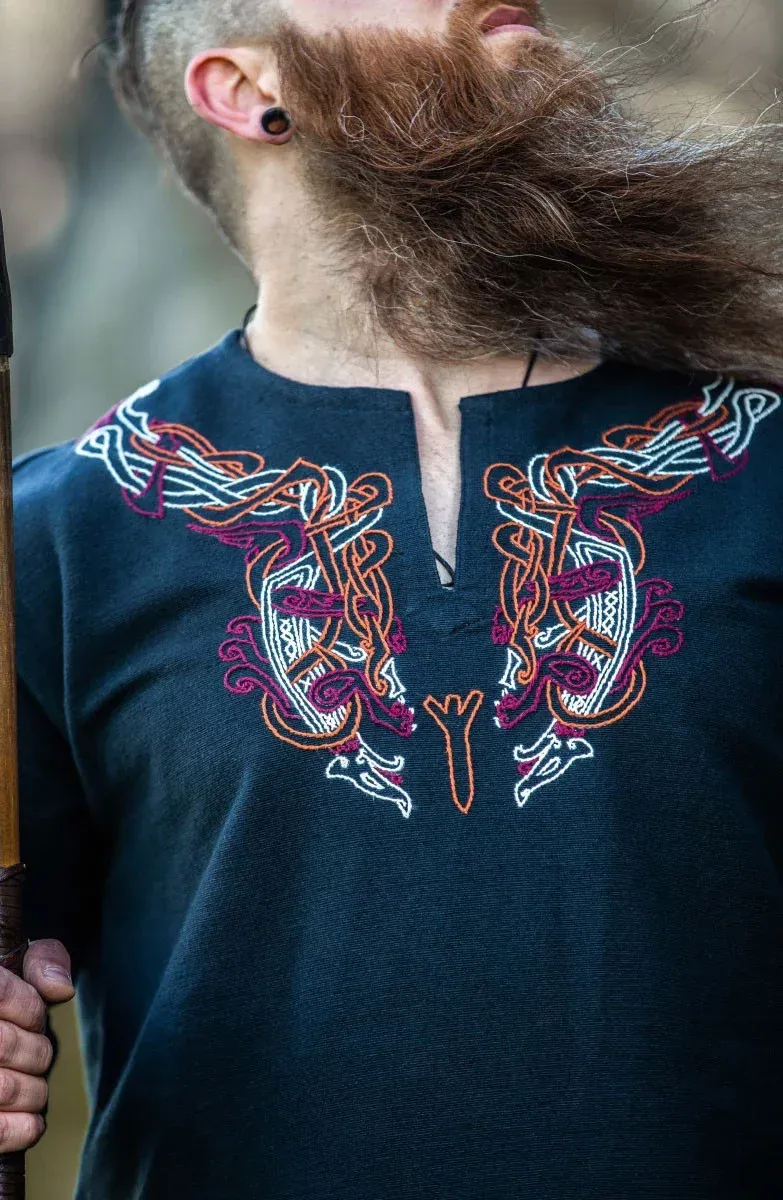
Historical Context and Evolution
This style is a refinement of the earlier Ringerike style, known for its curved and elegant lines. The rise of the Urnes style corresponds with the Christianization of the Vikings, a change that significantly influenced their artistic expressions. During this time, Nordic decorative motifs began to adapt to complement the new religious approach. This process is visible in how the represented animals, which were initially shown in circular or open compositions, transformed into linear ornaments that defined the Urnes style.
Manifestations and Notable Examples
The Urnes style is primarily found in:
- The carved portal of the wooden church of Urnes, its most famous piece.
- Runestones, particularly in Uppland, Sweden.
- Runestones dedicated to historical events such as the Danegeld and Canute the Great.
- Decorative elements such as silver bowls found in Lilla Valla.
- Works signed by the artist Åsmund Kåresson.
In Denmark, there are about 100 objects and fragments featuring the Urnes style, highlighting its extensive influence in the Nordic regions.
Influences and Artistic Connections
The Urnes style is not an isolated style. It shows relationships with:
- Celtic and Anglo-Saxon art, evident in the similarities with spiral patterns found in the Lindisfarne Gospels.
- The sophisticated evolution of the earlier Ringerike style.
This Viking art reflects the culmination of almost 700 years of artistic tradition that dominated Northern Europe from the 5th to the 12th century. The Urnes style represents the last vestige of traditional Viking art before Christianization transformed the cultural landscape of Scandinavia. It is remembered as one of the most refined examples of Viking artistic capability, combining centuries of stylistic evolution into an elegant and rich conclusion.
The Ringerike style is one of the most distinctive manifestations of Viking art, which flourished approximately between the 10th and 11th centuries. Named after the Ringerike region in Norway, the style is famous for its decorated runestones, which provide a vibrant testimony to the visual culture of the Vikings of that time. It is considered an evolution of the Mammen style, with a marked preference for zoomorphic ornamentation and mythological motifs.
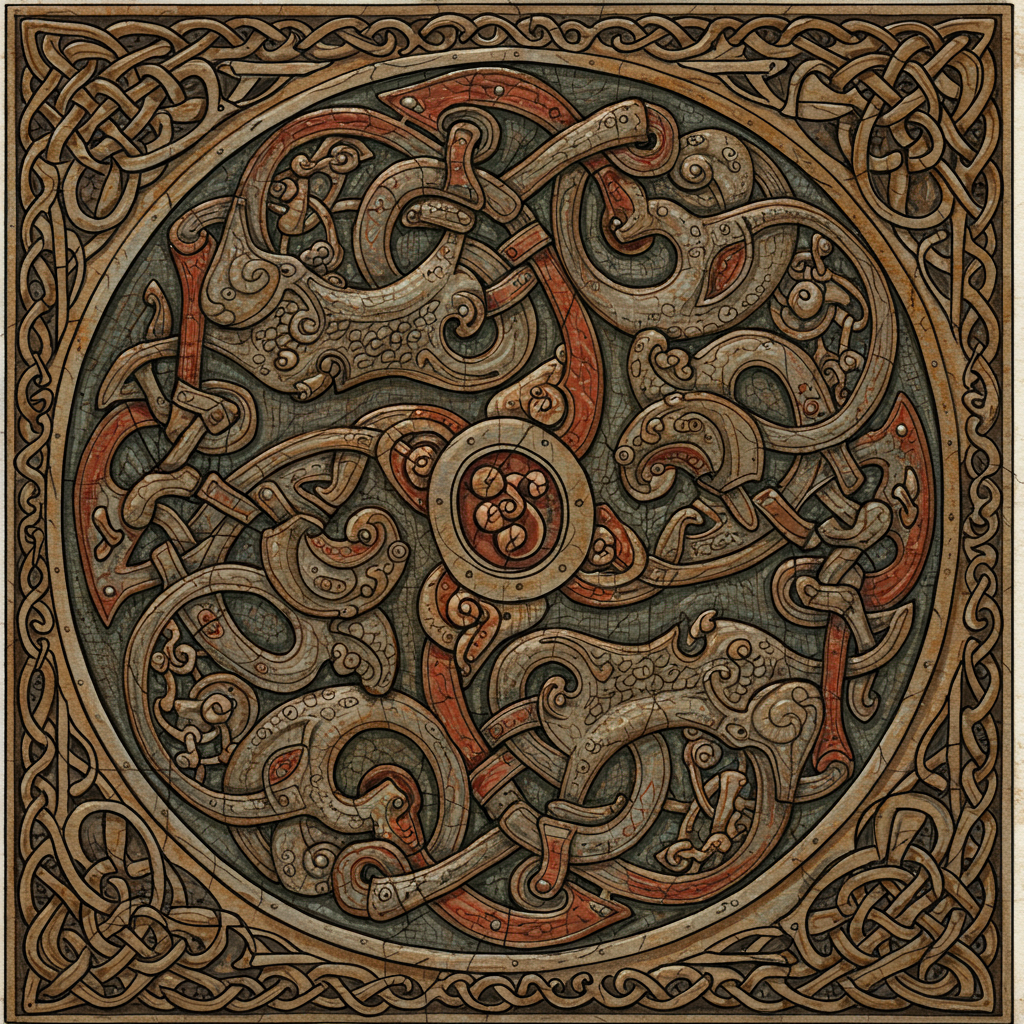
Characteristics of the Ringerike Style
This style is distinguished from other Viking styles by its rich representation of animals and plant motifs. The Ringerike zoos include lions, birds, snakes, and dragons, which are depicted in elongated and stylized forms. The distinctive feature is the faces of the animals, which often have almond-shaped or round eyes. Moreover, the plant themes, such as tendrils and plants in intertwined designs, show a clear influence from Anglo-Saxon and Ottonian art.
Influences and Diffusion
Although this style is named after a specific region, its development likely took place in Danish centers and spread throughout Scandinavia, even reaching England and Ireland. The rise of the Ringerike style coincided with the tradition of erecting runestones, providing an ideal platform for its dissemination as an integral part of late Viking art.
Elements and Symbolism
- Crosses and Palmettes: The Ringerike style is notable for the incorporation of crosses and palmettes in its designs, reflecting the interaction with Christianity and contemporary European art.
- Symmetry and Asymmetry: Although many designs are based on rigid symmetry, especially in plant compositions, they often exhibit dynamic asymmetry, introducing an element of movement and life into the works.
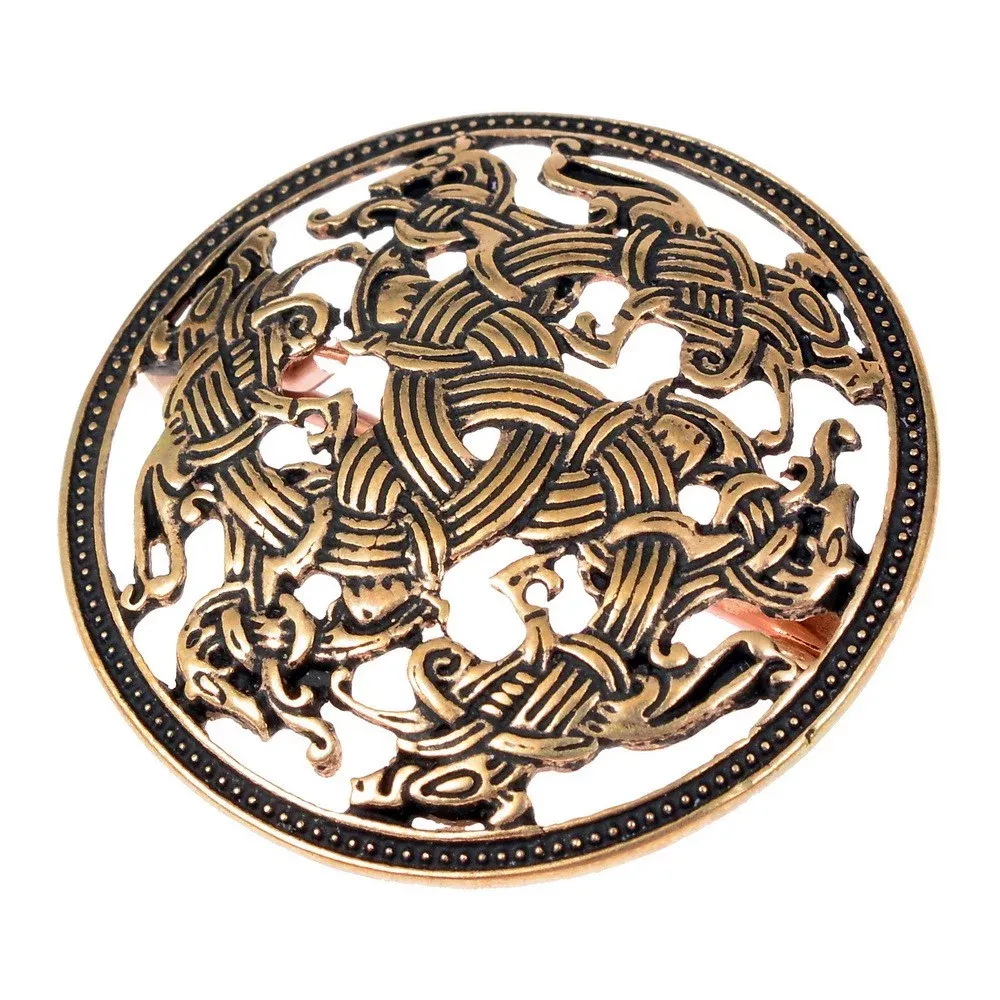
Representative Works
This artistic style is reflected in several significant works:
- Vang Stone: One of the most iconic runestones, adorned with intricate plant and animal motifs arranged in spirals.
- Söderala Weathervane: Vividly displays intertwined animals and plant patterns, showcasing the craftsmanship of the era.
Historical Context
The emergence of the Ringerike style coincided with a period of cultural and political transformation in Scandinavia. The expansion of Christianity and contact with other cultures, especially Anglo-Saxon and Ottonian, left an imprint on the stylistic development and choice of artistic motifs.
In essence, the Ringerike style embodies the complexity and evolution of Viking art, with its wealth of zoomorphic and plant details, as well as the cultural fusion reflected through the exchange of ideas during the late Viking period. Its influence and legacy extend beyond Scandinavia, reaching the British Isles, demonstrating the geographical reach and artistic durability of this vibrant style.
The bearded axe is an iconic tool and weapon known for its characteristic "beard," an extension of the blade that grants both functionality and a unique aesthetic. The Vikings, who referred to this type of axe as skeggöx, popularized it during the period from the 8th to the 10th centuries. However, its use was not limited to Scandinavian lands, as its versatility made it a common tool in various European cultures.
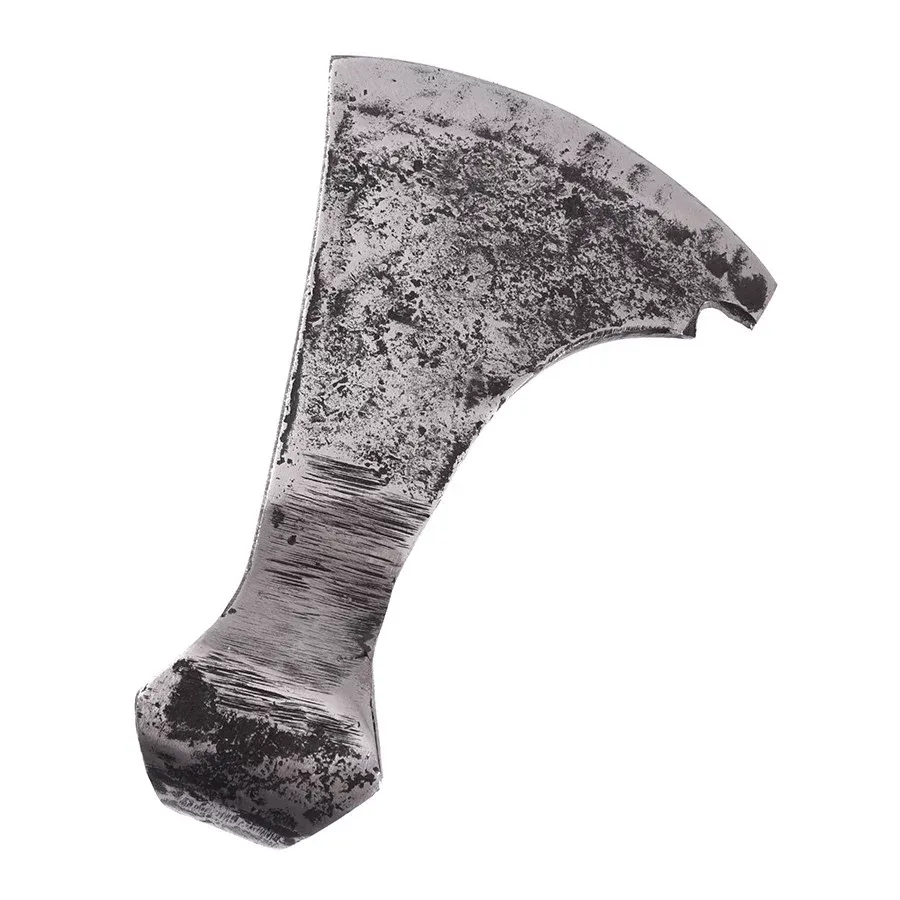
Origin and Historical Use of the Bearded Axe
The Viking Age witnessed the popularization of the bearded axe as one of the primary combat weapons. In Icelandic sagas and medieval documents, this instrument is frequently mentioned, not only as a weapon but also in daily activities. Archaeological findings, such as those made in the River Thames, suggest that these axes had extensive use and perhaps a ritual or symbolic value.
Distinctive Features
- Head Shape: The most distinctive feature is the "beard," an extension of the blade that allows for hooking weapons, shields, and even climbing walls.
- Size: Ranges from lightweight one-handed models to larger versions. Most of these axes are designed for agile use with one hand.
- Materials: Generally, the blade is made of steel or wrought iron, while the handle is crafted from sturdy woods like ash or walnut.
- Versatility: Used in both combat and daily tasks. Its extended blade made it ideal for chopping wood, butchering animals, or preparing stakes.
Cultural and Symbolic Importance
In addition to its practical utility, the bearded axe is a symbol of status and skill. In Norse mythology, as well as in artistic representations, it appears as an emblem of strength and cultural heritage. Runes, such as Othala, are associated with these axes, symbolizing a connection to ancestral land and family legacy. In modern times, many replicas recreate these designs for collectors or historical reenactments.
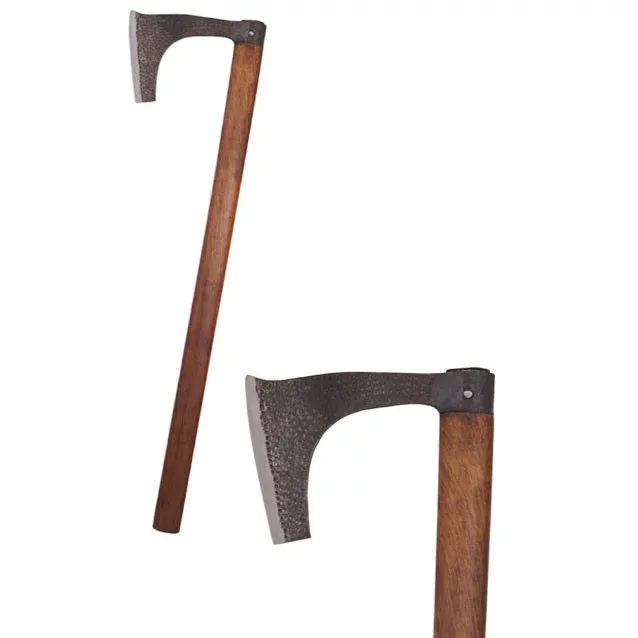
Advantages and Practical Uses
- Combat Hook: The extension of the blade allowed for hooking and destabilizing enemies, a crucial tactical advantage in battles.
- Efficiency in Daily Tasks: Its design was perfect for felling trees, hunting, or cutting due to the control and extension of the blade.
- Adaptability: Its lightweight nature made it easy to use with one hand, allowing warriors to carry a shield in the other.
| Aspect | Description |
|---|---|
| Head Shape | Extension of the blade forming a "beard" |
| Size | Ranges from lightweight one-handed to larger sizes |
| Materials | Steel or iron blade; ash or walnut handle |
| Versatility | Useful in combat and everyday tasks |
In the history of tools and weapons, the bearded axe occupies a special place due to its creative design that effectively combines functionality and symbolism. The enduring image of the Viking warrior with his bearded axe remains a fascinating vision of the past and a timeless emblem of craftsmanship and tactical skill.
The **Roman capsa** is a fascinating invention from antiquity that reflects the ingenuity of classical civilizations, specifically during the period of Ancient Rome. This archaeological piece, essentially a cylinder that served as a container, was designed to store and transport **papyrus or parchment rolls**, also known as *volumina*. In ancient times, when printed books were still a concept to be discovered, rolls played the role of repositories of knowledge and were fundamental for the preservation and accessibility of written information.
.webp)
Origin and Innovation
The original **capsae** have their roots in Ancient Greece, but their use quickly spread throughout the Greco-Roman world, solidifying in Roman society. These cylindrical structures became essential tools not only for scholars and officials but also for physicians and citizens handling important documents or items. The Greek term for these boxes is *kibotoi*, and when they were dedicated exclusively to document storage, they were known as *scrinium*.
Structure and Materials
The capsae were cylindrical baskets with a lid, commonly made from durable materials such as **wood or leather**. These containers effectively protected the internal content from damaging factors such as moisture or constant handling. Their design allowed them to be portable: they featured a **long strap** that facilitated carrying at the waist or slung over a shoulder, ideal for the constant travel or movement required by life during that time.
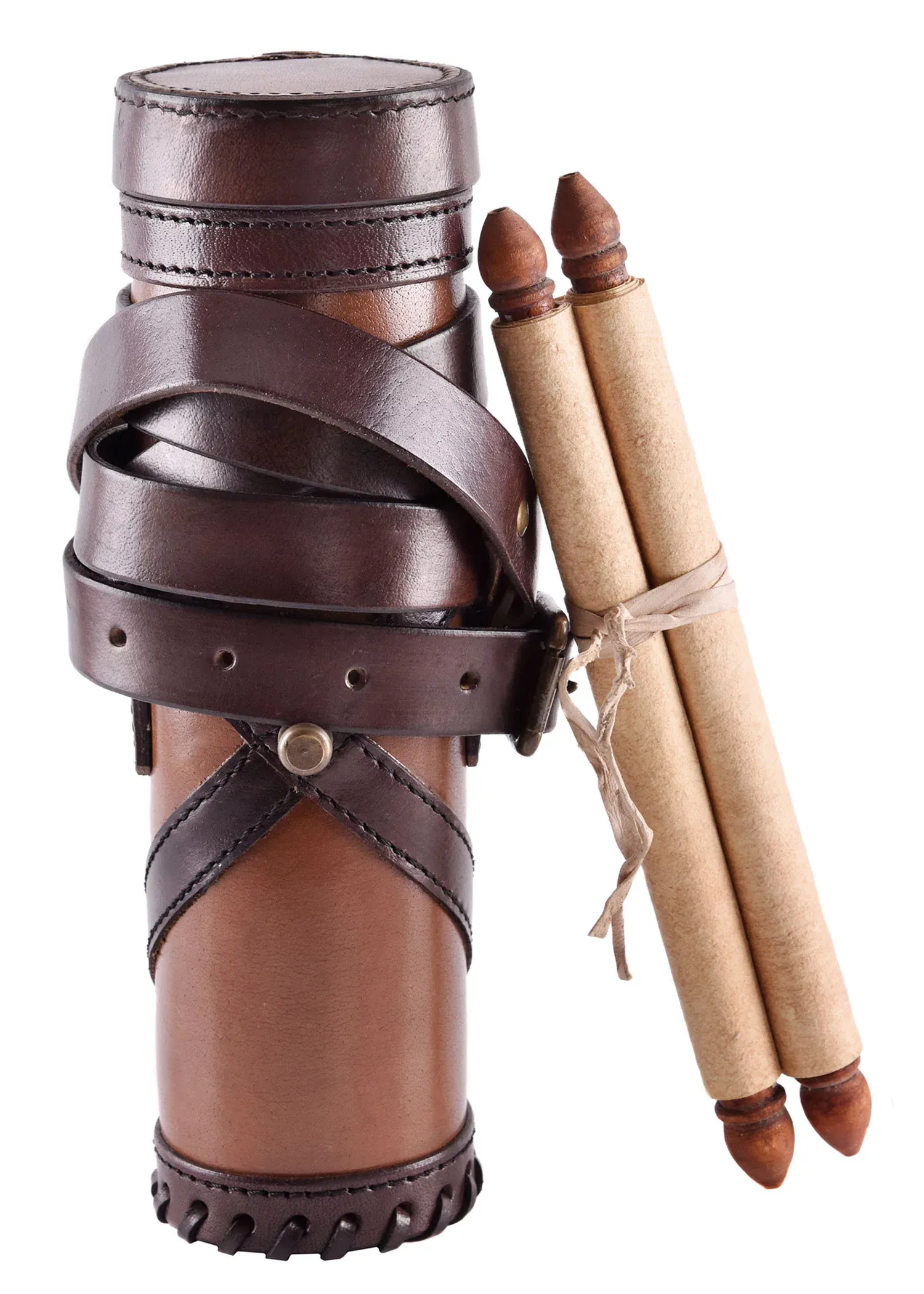
Purposes and Uses
The primary function of a capsa was to **preserve and protect the rolls** from environmental and handling deterioration, thereby ensuring their longevity. In addition to being popular in libraries, where they preserved that cultural treasure, capsae had specific uses. In medical contexts, the **capsarii** —assistants to Roman surgeons— used capsae to transport essential items such as bandages and tools. Also, some capsae played a role in funerary practices, containing the deceased's personal effects.
Cultural and Technical Legacy
Capsae represent a bridge in the evolution of document supports, preceding the codex, which is considered the direct ancestor of the modern book. The mechanics of protection and transport offered by the capsae laid the groundwork for future advancements in areas such as archival science and library science.
Curiosities
- The exterior could be labeled, facilitating the identification of the content without having to open it.
- It provided space not only for rolls but also for **wooden tablets or writing instruments**.
- The term **capsa** has evolved, relating to various specialized containers in modern times.
The Roman capsa, beyond its basic functionality, symbolizes humanity's commitment to **preserving knowledge** and the constant effort to improve access to information. It is a testament to how practical solutions from the past have helped shape the world of knowledge and written culture that we enjoy today.
In the study of weapons used throughout history, the caltrop stands out for its ingenious design and tactical effectiveness. Often unknown to most, this military device has been an important element in multiple cultures and battles.
What is a caltrop?
A caltrop, known in Latin America as a "miguelito," is a defensive device made up of four or more sharp metal spikes a few centimeters long. These spikes are arranged so that when thrown on the ground, one of them always remains upright, ready to cause harm. This tetrahedral shape ensures the other spikes form a stable base.
.webp)
The simplicity of its construction allows them to be scattered in large quantities over terrain, creating areas difficult to traverse. The term "caltrop" comes from the expression "open eye," warning those who find them to remain vigilant.
A journey through its history
Caltrops trace back to ancient times. It is known that in 348 B.C., during the Battle of Gaugamela, Alexander the Great implemented these devices in his military tactics, as recounted by Quintus Curtius Rufus. Likewise, the Romans knew them as "tribulus" or "murex ferreus," naming them after the spiny plant Tribulus terrestris.
In the Middle Ages, the Scots used caltrops at the Battle of Bannockburn in 1314, playing a crucial role in halting the advance of the English cavalry.
Cultural variants of the caltrop
Different cultures have adapted the caltrop to their specific needs:
- In Japan, they were called "makibishi" or "tetsubishi," used by ninjas and samurai, working effectively indoors due to the custom of not wearing shoes in enclosed spaces.
- Known as "calcitrappa" in medieval Latin, a term referring to their ability to pierce feet.
- In Latin America, the term "miguelito" became popular, possibly referencing the Chilean revolutionary Miguel Enríquez, who used them in various actions.
Military applications and tactics
Throughout history, caltrops have been used for multiple purposes:
- Against cavalry: Ideal for stopping mounted troops by injuring the legs of animals like horses.
- Against infantry: Especially effective against soldiers wearing light footwear.
- Naval applications: They were launched from catapults in Byzantine warfare strategies.
- Contemporary use: In recent conflicts, they have been used to deflate vehicle tires.
- During the Vietnam War: In this conflict, some versions were coated with poison to cause infections.

The art of "area denial"
The caltrop is classified as an "area denial" weapon, designed to prevent movement or access to certain areas. In this sense, its functions include:
- Slowing enemy advance
- Channeling movements towards advantageous positions
- Disrupting military formations
- Inflicting physical damage, reducing operational capacity
Current presence and legacy
Despite its ancient design, caltrops are still used in modern police control actions and conflict situations. The simplicity and effectiveness of their design have preserved their relevance through the centuries, even being featured in popular culture media such as films and video games depicting medieval times.
In conclusion, this device, simple yet incredibly effective, is a testament to the ingenuity and adaptability of military design throughout history.
Vexillology is dedicated to the fascinating world of the study of flags, pennants, and banners. Derived from the Latin word vexillum (flag) and the Greek logos (knowledge), this term literally means “knowledge of flags.” Originally part of heraldry, vexillology has evolved into an independent discipline with broad scope in the semiotic field, interpreting these symbols as sign systems loaded with social, cultural, and political meaning.

Brief History and Consolidation
Vexillology began to take shape as an autonomous field from the second half of the 20th century. In 1957, the American scholar Whitney Smith coined the term and promoted its use. In 1967, the International Federation of Vexillological Associations (FIAV) was founded, an organization that brings together experts from around the world and organizes a biennial congress. This federation has been fundamental in the expansion and consolidation of vexillology as an academic and professional discipline.
Key Aspects of Vexillology
Within its field of study, vexillology encompasses multiple dimensions:
- Designs, shapes, and proportions: Analyzes the geometry and structure of flags as well as their visual patterns.
- Symbols, colors, and iconography: Investigates the symbolism behind colors, coats of arms, and emblems.
- History and evolution: Focuses on the origin and transformation of flags over time.
- Uses and customs: Examines the historical and cultural context in which flags are used.
- Design standards and principles: Establishes rules of simplicity, uniqueness, and visibility for effective design.

The Vexillologist: Specialist in Flags
The person dedicated to the study of vexillology is called a vexillologist. These specialists work in diverse fields such as history, anthropology, sociology, design, or even politics. Vexillologists not only analyze and document existing flags but also collaborate in designing new ones, advising on the correct use and meaning of these symbols.
Current Importance and Social Linkages
Flags are not mere pieces of cloth; they serve a crucial function as collective representation and identity. They express values, history, and belonging to groups, nations, or social movements. The role of vexillology is vital for deciphering these visual communication codes and for helping protect symbolic heritage.
Basic Principles of Vexillological Design
The universal principles of effective flag design include:
- Simplicity: To ensure they are easily recognizable.
- Clear symbolism: So meanings are expressed directly.
- Use of few colors: To allow high visual contrast.
- Avoid inscriptions or coats of arms: To facilitate quick identification.
- Distinction and uniqueness: They must clearly differ from other flags.
Vexillology not only enriches our understanding of flags but also helps us comprehend how these emblems function as vital pieces in the cultural and political mosaic of our society.
A trebuchet, also known as fundibulum or almajaneque, is a medieval siege engine designed to hurl large projectiles using the principle of the lever. Its primary uses were to breach walls, assault fortified places, or sow panic by delivering offensive and biological materials. More than a simple catapult, the trebuchet represents an engineering solution that combines weight, momentum and geometry to achieve long ranges and high impact energy.
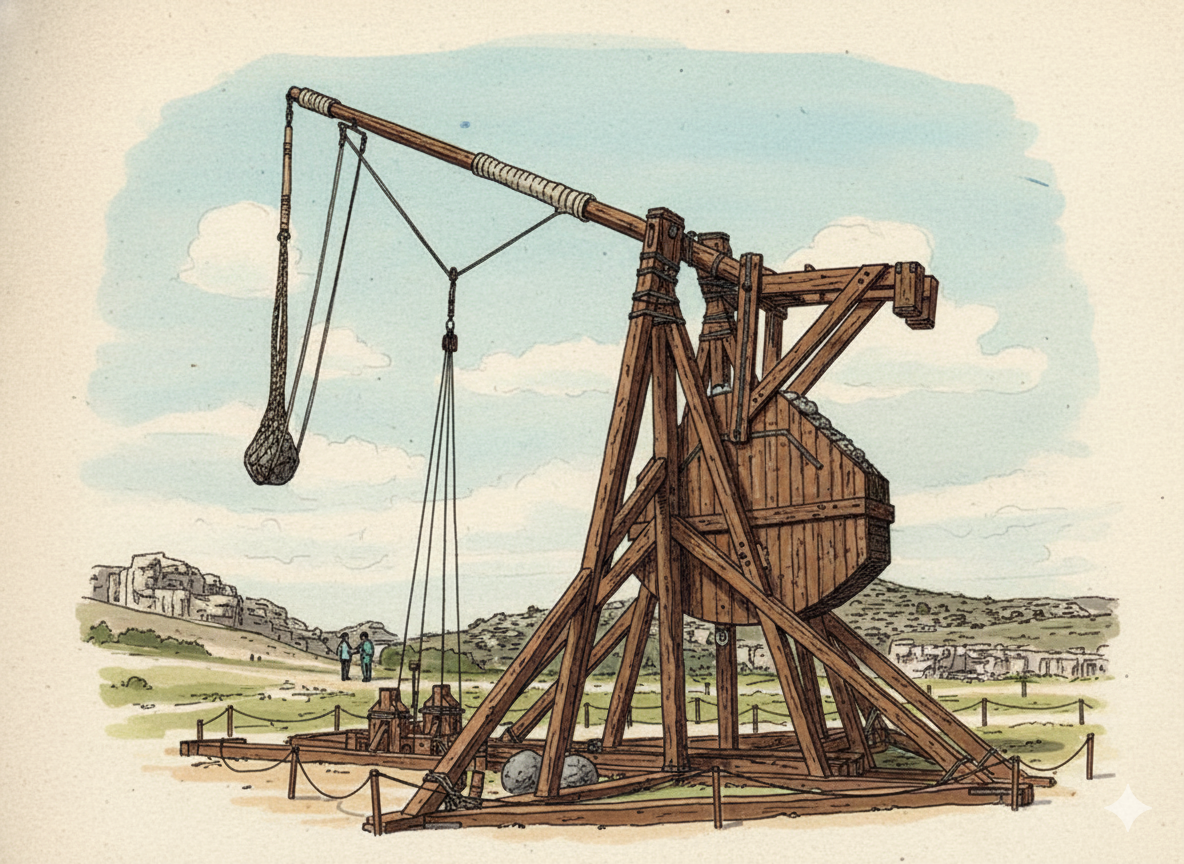
Origin and historical evolution
The origin of the fundibulum is located in ancient China, between the 5th and 3rd centuries BC, in an early phase of traction machines in which launching depended on human strength. From there, the idea traveled westward via nomadic peoples and military contacts: the Avars and, later, the Byzantine Empire adopted and transformed these mechanisms.
The major breakthrough came with the introduction of the counterweight fundibulum, a more powerful and consistent version that replaces human force with a heavy counterweight. This design became widespread in the Mediterranean around the 12th century and, via Mongol routes and conquests, spread back into Asia in later centuries.
How it works (educational explanation)
The trebuchet basically operates like a first-class lever with an off-center pivot:
- Short arm: holds a counterweight —multiple tons in large models— which, when dropped, provides the energy.
- Long arm: ends in a sling or receptacle where the projectile is placed.
- Axis of rotation: offset from the center of the beam to amplify the movement and speed of the long end.
- Holding and release mechanism: secures the arm until the trigger allows the controlled drop of the counterweight.
When the mechanism is released, gravity causes the counterweight to fall; this energy is transmitted through the lever, accelerating the long end and launching the projectile. Depending on size and design, some fundibula reached more than 200 meters of effective range.
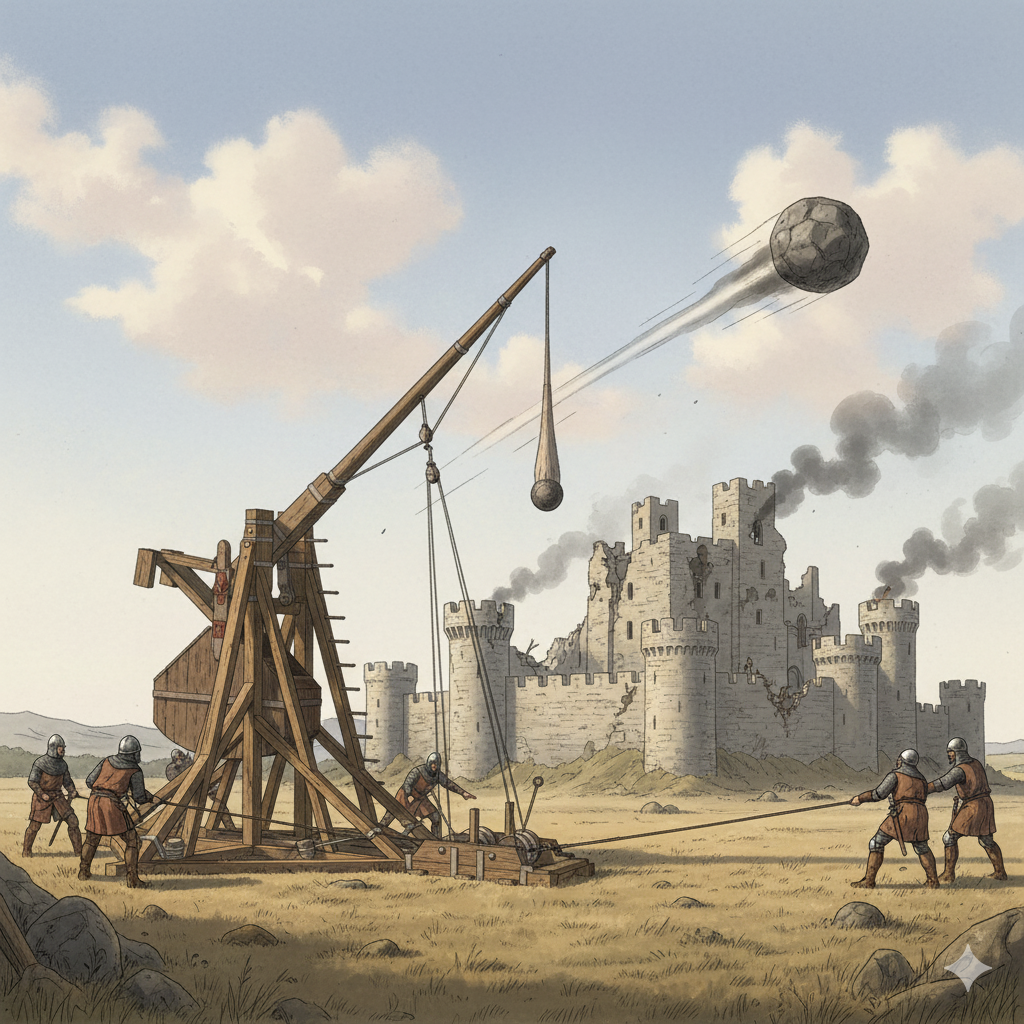
Mechanical variants
- Traction fundibulum: several operators pulled ropes on the short arm; simpler but with less power and precision.
- Counterweight fundibulum: uses a heavy mass to obtain consistent energy and greater range.
Types of projectiles and uses
Projectiles went beyond stones: their purpose was not only physical but also psychological and sanitary.
- Large stones to bring down walls or towers.
- Incendiary materials (tar, oil, torches placed in containers).
- Objects intended to create panic: heads, corpses or remains in advanced states of decay.
- Biological elements (dead animals, beehives) to spread disease or cause disruption.
- Ceramic spheres filled with incendiary substances or basic chemical agents.
Tactical impact and historical examples
The trebuchet forced a rethink of defensive designs: wider moats, offset towers and reinforced walls. Among the most cited milestones:
- The so-called "Warwolf", built by order of Edward I during the siege of Stirling (1304), was one of the largest recorded machines and reportedly launched projectiles of over 100 kg long distances.
- Documents from campaigns in the Iberian Peninsula and the Mediterranean mention its use in sieges of castles and towns from the 12th to the 15th centuries.
- In the Americas, during the Conquest, there are occasional accounts of attempts to adapt similar technologies when gunpowder artillery was lacking.

Decline and legacy
The spread of gunpowder and gunners with cannons capable of breaching walls at a distance reduced the trebuchet's advantage. From the 16th century onward its military use declined and it became an object of historical reconstruction and study in ancient engineering. Today it remains a reference in the history of military technology and a common feature in experimental archaeology projects.
| Aspect | Traction trebuchet | Counterweight trebuchet |
|---|---|---|
| Power source | Human power | Counterweight (gravity) |
| Shot consistency | Variable | High |
| Typical range | Lower (tens of meters) | Greater (hundreds of meters in large models) |
| Construction complexity | Lower | Higher |
| Preferred use | Quick, improvised campaigns | Planned, large-scale sieges |
The study of the trebuchet combines history, basic physics and experimental archaeology. Understanding its design helps appreciate how, with simple materials and elementary mechanical principles, devastating effects were achieved on the medieval battlefield.
The lituus (or lituo in Spanish) is an ancient term with a double meaning: on the one hand, it denotes a brass-wind instrument of Etruscan origin used by the Romans; on the other, a curved ritual staff employed by augurs and other priests in ancient Rome. Both manifestations —musical and ritual— share the same image of curvature and authority, although they served different functions in society.
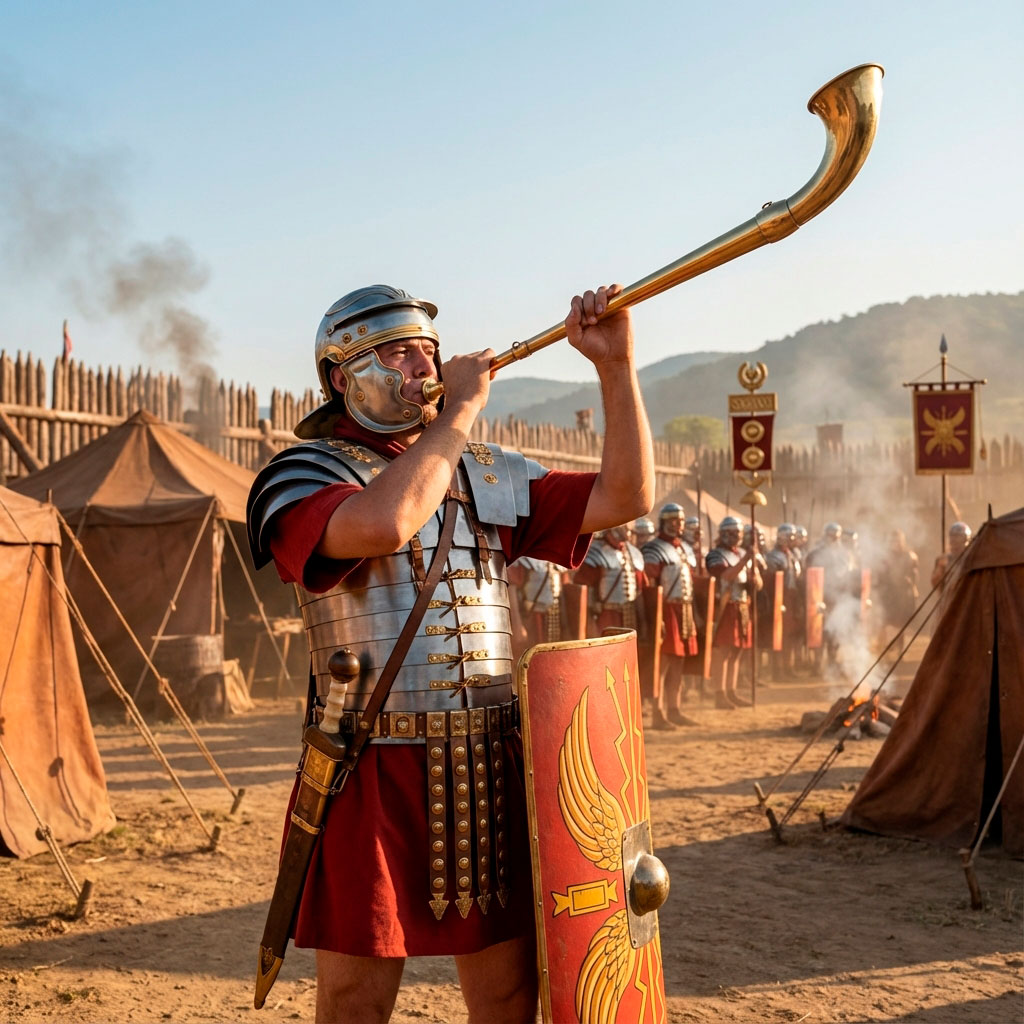
Origin and history
The word comes from Etruscan and entered Roman language and culture while retaining the idea of something twisted or curved. The lituus, as an instrument, appears to derive from ceremonial trumpets of the ancient Mediterranean world and was widely adopted by Rome in military and religious contexts. At the same time, the lituus staff became part of the set of priestly symbols used to mark sacred boundaries or denote the authority of the augur.
The lituus as a musical instrument
Physical characteristics
- Shape: a long cylindrical tube ending in a hooked curve, similar to a “J”.
- Materials: typically bronze; versions in wood or with metal coverings are also known.
- Size: ranged from approximately 75 cm to 1.40 m, which affected its register and sound projection.
Sound and functions
- Timbre: bright and piercing, designed to be heard over long distances.
- Practical functions: signals and commands on the battlefield (especially for cavalry), marking rhythms in processions, and accompaniment in funeral ceremonies.
- Sonic symbolism: the sound of the lituus conveyed authority and organizational cohesion in military formations and public rituals.
Evolution
- In the Middle Ages the word “lituus” may have been applied to similar signal trumpets and horns.
- There is evidence of variants and adaptations into later periods, although its primary function as a signaling instrument remained.
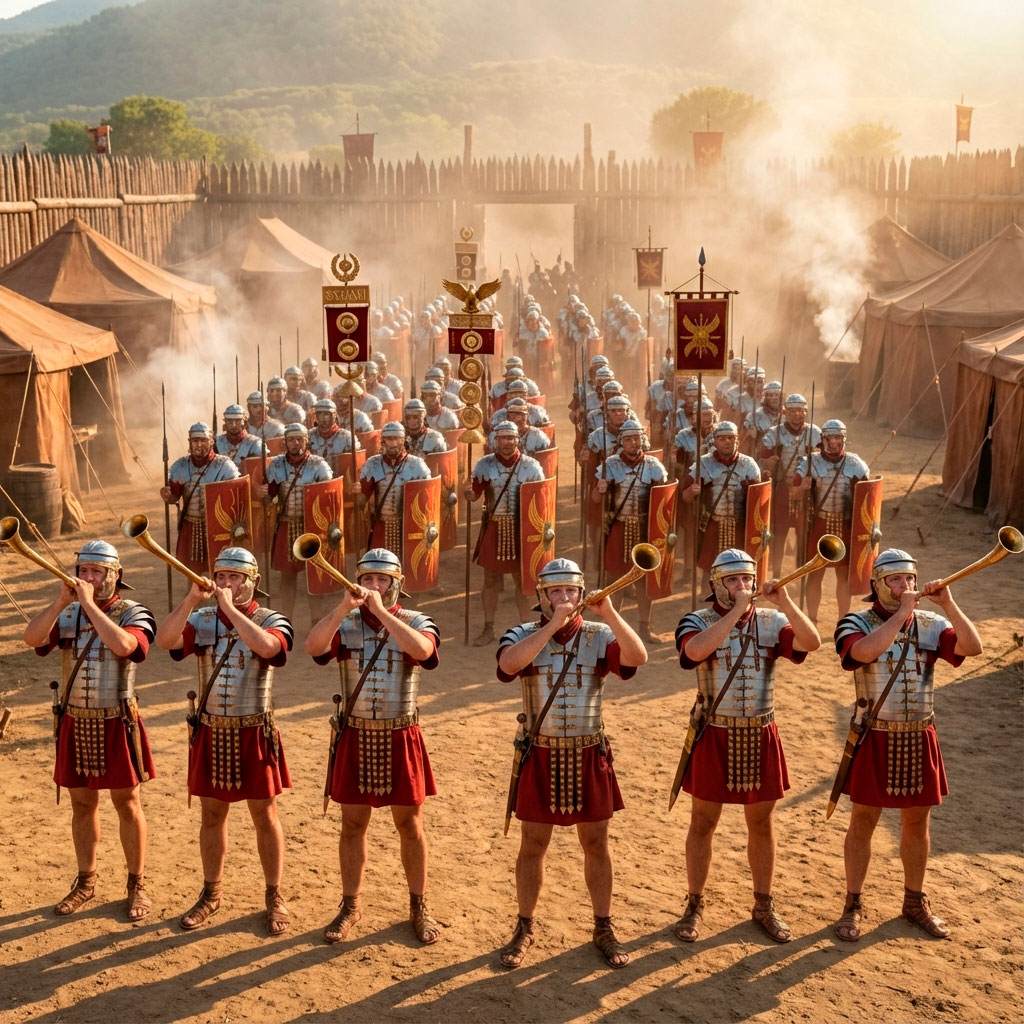
The lituus as a ritual staff
Beyond its sonic use, the lituus appears repeatedly in Roman religious iconography as a curved staff associated with the practice of augury and priestly investiture.
- Use by augurs: it was used to trace in the sky the sacred space (the aerial “templum”) where auspicious signs were interpreted.
- Sign of authority: in statuary and coins it indicates the figure’s status as a magistrate or member of the priestly college.
- Symbolic form: the curvature suggests a tool for delimiting and reading celestial signs; it was not a mere ornament, but a ritual instrument with juridical-religious meaning.
Iconography, finds and presence in art
The lituus is common in sarcophagi, reliefs, coins and Roman and Etruscan statuary. Its depiction helps identify social roles (military, priestly) and provides clues about ceremonial and organizational practices in antiquity. Archaeological sites and iconographic sources allow reconstruction of both its physical appearance and its symbolic importance in public and funerary contexts.
Quick comparison: instrument vs. ritual staff
| Aspect | Lituus (instrument) | Lituus (ritual staff) |
|---|---|---|
| Function | Sound signaling and ceremonial accompaniment. | Marking sacred boundaries, symbol of religious authority. |
| Material | Bronze, sometimes wood or combinations. | Wood or metal, more oriented toward symbolism than sound. |
| Context | Military, processions, funerals. | Augural practices, religious and official iconography. |
| Representation | Curved instrument, often shown with musicians or in marching scenes. | Present in statues, coins and reliefs alongside priests or magistrates. |
Notes on its legacy
The lituus remains an object of interest for musicologists, archaeologists and scholars of ancient religion for its ability to articulate practical aspects —sonic communication in open environments— and symbolic aspects —appearing as an emblem of power and sacrality. Its double dimension makes the term a good example of how a material object can play very different roles within the same culture.
















